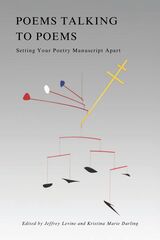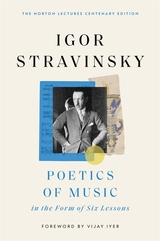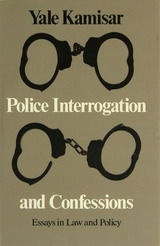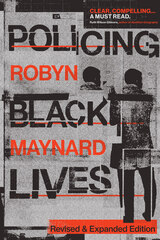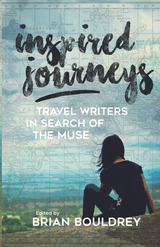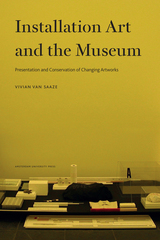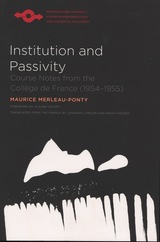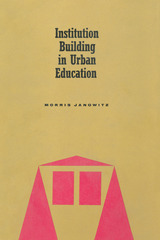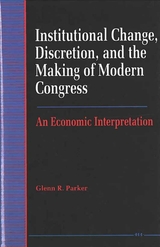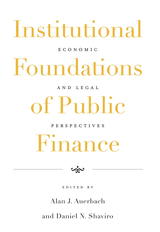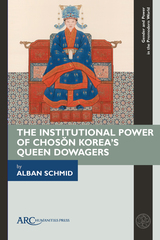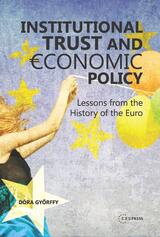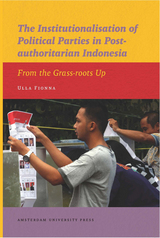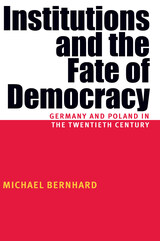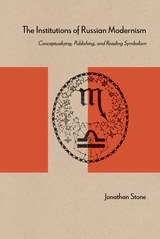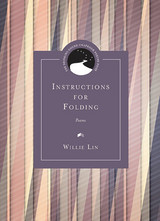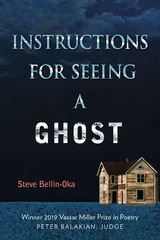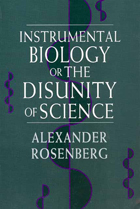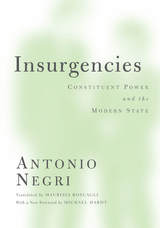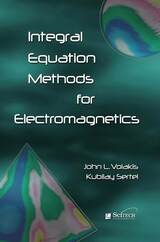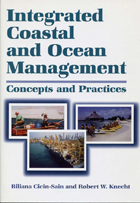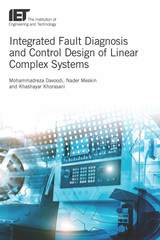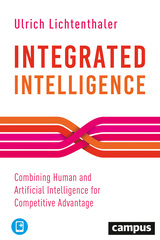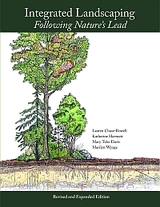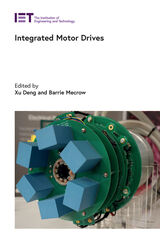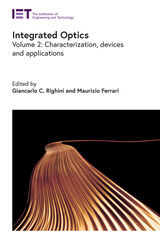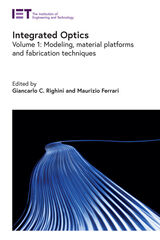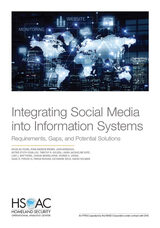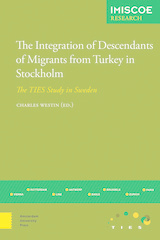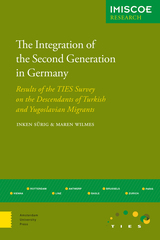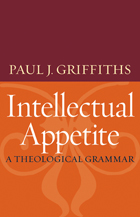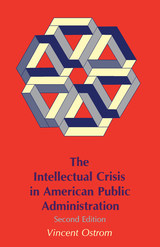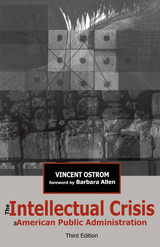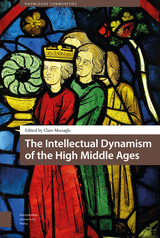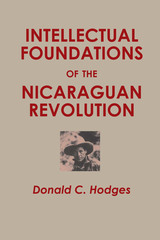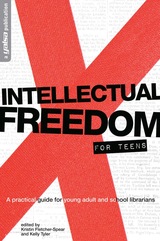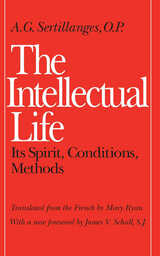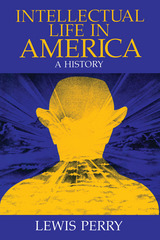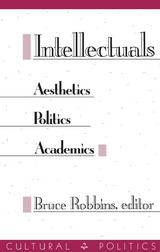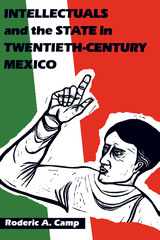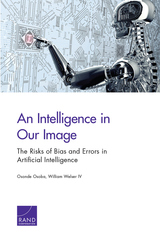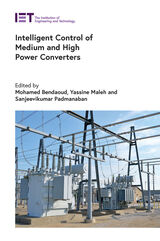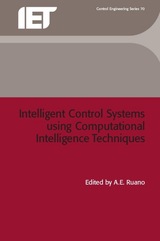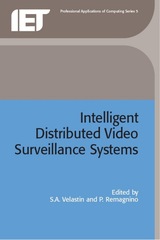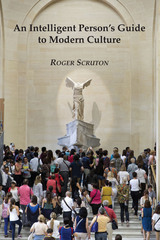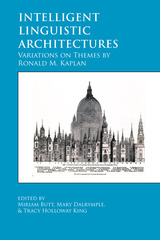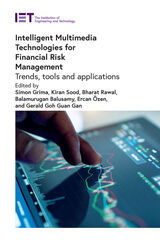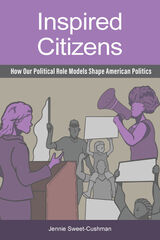 Inspired Citizens: How Our Political Role Models Shape American Politics
Jennie Sweet-Cushman
Temple University Press, 2024 Political role models are people that voters form a connection with, and who provoke them to think differently about and engage with politics. Inspired Citizens examines the impact role models have in American politics through the lens of political psychology. Jennie Sweet-Cushman investigates how citizens, especially marginalized ones, can be influenced by the presence of political role models. She asks critical questions: Do role models increase political participation and strengthen American democracy? Do role models encourage candidate emergence?
Sweet-Cushman develops Inspired Citizenship Theory to show that political role models can have motivating effects on one’s political citizenship and may, in some case, insulate those who have been traditionally marginalized in American politics. Moreover, she asserts that citizens who have political role models possess very different political behaviors and attitudes than those who do not.
Inspired Citizens also considers the often-conflicting pressures and messages political role models project to citizens. Sweet-Cushman posits that role models inspire political action most effectively when they fulfill highly individualized expectations for role model identity, spurring deeper connection and a desire to emulate.
Inspired Citizens strengthens our understanding of what we should (and should not) look to political figures for in guiding democratic behaviors and inspiring productive citizenship.
Inspired Journeys: Travel Writers in Search of the Muse
Edited by Brian Bouldrey
University of Wisconsin Press, 2016 Full of humor, profundity, and obsession, these are tales of writers on peregrine paths. Some set out in search of legends or artistic inspiration; others seek spiritual epiphany or fulfillment of a promise. Their journeys lead them variously to Dracula’s castle, Laura Ingalls Wilder’s prairie, the Grimms’ fairy-tale road, Mayan temples, Nathaniel West’s California, the Camino de Santiago trail, Scott’s Antarctica, the Marquis de Sade’s haunted manor, or the sacred city of Varanasi. All of these pilgrimages are worthy journeys—redemptive and serious. But a time-honored element of pilgrimage is a suspension of rules, and there is absurdity and exuberance here as well.
Inspiring Writing in Art and Design: Taking a Line for a Write
Pat Francis
Intellect Books, 2009 When art and design students are asked for statements to accompany their work, reflective journals, or critiques, reviews and essays, they often freeze up because they have to put their thoughts in writing. Although these students are comfortable expressing themselves visually, they lack confidence working with words. Inspiring Writing in Art and Design is a practical aid for those students who are disheartened or overwhelmed by having to write. Pat Francis provides short writing exercises and creative writing techniques for tutors to use and which will help art and design students develop their ability to verbally articulate the concepts and aesthetics behind their art. Using Francis’s examples, students will build confidence and skills that can help them succeed in presenting their work and themselves in, and beyond, the studio world.
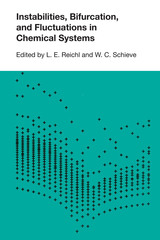 Instabilities, Bifurcations, and Fluctuations in Chemical Systems
Edited by L. E. Reichl and W. C. Schieve
University of Texas Press, 1982 Twentieth-century research in the field of chemical pattern formation saw extraordinary progress due to the pathbreaking contributions of Nobel laureate Ilya Prigogine and his co-workers. Evidence exists that the dissipative structures studied by Prigogine and his colleagues may play a dominant role in the processes of self-organization of biological systems, the fundamental phenomena that govern all life forms. Brought together in this valuable volume are topical papers from the this research. Important aspects of nonlinear chemical pattern formation—dissipative structures—in chemical, biochemical, and geological systems are surveyed by leading scientists in the field of nonlinear chemistry. Topics covered include experimental observations of pattern formation in a variety of systems, bifurcation theory and analysis of nonlinear chemical rate equations, and the stochastic theory of nonlinear chemical reactions. Of particular interest are the studies of the effects of electric fields on the determination of nonequilibrium states of chemical systems.
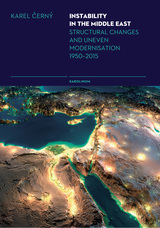 Instability in the Middle East: Structural Causes and Uneven Modernisation 1950–2015
Karel Cerný
Karolinum Press, 2017 Middle Eastern instability is manifest externally in many ways: by crises afflicting governing regimes, the rise of political Islam, terrorism, revolution, civil war, increased migration, and the collapse of many states. This book examines the roots of this instability using a theoretically original and empirically supported historical-sociological comparative analysis. Countering common interpretations of postcolonial Middle Eastern development, Instability in the Middle East focuses on the highly uneven and unsynchronized pace of change in individual sociodemographic, economic, and political dimensions of modernization. Drawing on the theory of multiple modernities, Černý investigates the broader cultural, religious, and international political context of uneven modernization in the Middle East and tests his model using a time series of dozens of indicators over the past fifty years, revealing a long-term trend of cumulative change across the region.
Instafame: Graffiti and Street Art in the Instagram Era
Lachlan MacDowall
Intellect Books, 2019 Instafame charts the impact of Instagram—one of the world’s most popular social media platforms—on visual culture in the mere eight years since its launch. MacDowell traces the intuitive connections between graffiti, street art, and Instagram, arguing that social media’s unending battle for a viewer’s attention is closely aligned with eye-catching ethos of unsanctioned public art. Beginning with the observation that the scroll of images on a sideways phone screen resembles nothing so much as graffiti seen through the windows of a moving train, Macdowell moves outward to give us a wide-ranging look at how Instagram has already effected a dramatic shift in the making and viewing of street art.
Installation Art and the Museum: Presentation and Conservation of Changing Artworks
Vivian van Saaze
Amsterdam University Press, 2013 Installation art has become mainstream in artistic practices. However, acquiring and displaying such artworks means that curators and conservators are challenged to deal with obsolete technologies, ephemeral materials, and other issues concerning care and management of these artworks. By analyzing three in-depth case studies, the author sheds new light on the key concepts of traditional conservation—authenticity, artist’s intention, and the notion of ownership—while exploring how these concepts apply in contemporary art conservation.
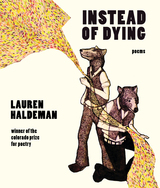 Instead of Dying
Lauren Haldeman
University Press of Colorado, 2017 Invoking spiders and senators, physicists and aliens, Lauren Haldeman’s second book, Instead of Dying, decodes the world of death with a powerful mix of humor, epiphany, and agonizing grief. In the spirit of Calvino’s Invisible Cities, these poems compulsively imagine alternate realities for a lost sibling (“Instead of dying, they inject you with sunlight & you live” or “Instead of dying, you join a dog-sledding team in Quebec”), relentlessly recording the unlived possibilities that blossom from the purgative magical thinking of mourning. Whether she is channeling Google Maps Street View to visit a scene of murder (“Because / a picture of this place is / also a picture of you”) or investigating the origins of consciousness (“Yes, alien / life-forms exist / they are your thoughts”), Haldeman wrenches verse into new sublime forms, attempting to both translate the human experience as well as encrypt it, inviting readers into realms where we hover, plunge, rise again, and ascend.
 Instigations: Ezra Pound and Remy de Gourmont
Richard Sieburth
Harvard University Press, 1978 At the beginning of this century, Remy de Gourmont was the embodiment of the literary avant-garde, not only for urbane European writers but for “American imbeciles,” in Ezra Pound's term. As this book shows, Pound himself was one of the many young artists who learned from him. Gourmont was a brilliant teacher, and the breadth of his imagination and the scope of his interests had a special impact on Pound, whose “provincial” mind was moving in the same ways but without the so-called civilized places to go.
Instead of elaborately tracing influences or sources, Sieburth juxtaposes various aspects of Gourmont's and Pound's works in order to arrive at a better understanding of their individual achievements as “instigators.” In doing so, he reveals unexplored dimensions of Pound's development—from his early reading of vers fibre to his discovery, through Gourmont, of the French Enlightenment. Pound emerges as a modern-day philosophe, and Sieburth's reevaluation casts new light on Pound's complex political ideas and on difficult areas of the late Cantos.
 An Instinct for War: Scenes from the Battlefields of History
Roger Spiller
Harvard University Press, 2005 Stories about war are some of the oldest stories told--used to entertain, to glorify, to lament, to educate. An Instinct for War utilizes myriad tales of war to offer a remarkable look at one of humanity's oldest plagues. Roger Spiller excavates the essence of war and its evolution through the words and thoughts of those who led--and those who were led--into battle, moving from the perspective of an ancient Chinese emperor to Napoleon's command, from a Civil War soldier's final days to the particularities of today's small wars throughout the globe.
Spiller combines a mastery of the primary sources with a vibrant historical imagination to locate a dozen turning points in the world's history of warfare that altered our understanding of war and its pursuit. We are conducted through profound moments by the voices of those who witnessed them and are given a graphic understanding of war, the devastating choices, the means by which battles are won and lost, and the enormous price exacted. Spiller's attention to the sights and sounds of battle enables us to feel the sting and menace of past violent conflicts as if they were today's.
A bold departure from standard military history, An Instinct for War will challenge our understanding of how war forever alters the landscape--both human and geographic--and how individuals can alter the nature of battle. This collective portrait of the life of war offers unparalleled insight into our struggle for mastery over a fundamental instinct.
Institution and Passivity: Course Notes from the Collège de France (1954-1955)
Maurice Merleau-Ponty
Northwestern University Press, 2010 Institution and Passivity is based on course notes for classes taught at the Bibliothèque Nationale de Paris. Philosophically, this collection connects the issue of passive constitution of meaning with the dimension of history, furthering discussions and completing arguments started in The Visible and the Invisible and Signs (both published by Northwestern). Leonard Lawlor and Heath Massey’s translation makes available to an English-speaking readership a critical transitional text in the history of phenomenology.
Institution Building in Urban Education
Morris Janowitz
Russell Sage Foundation, 1968 Presents a sociological perspective on the issues involved in transforming the structure of inner city schools. This book evaluates the models which have guided past and present attempts at educational reform, and proposes a coherent theory for attacking the problems of urban education. Dr. Janowitz examines the inner city school as a social system—the physical structure, community setting, people involved, and persistent patterns of behavior. He analyzes the current trend of specialization teaching and recommends instead an "aggregation" model which increases the scope of the individual teacher and restructures the climate of the school.
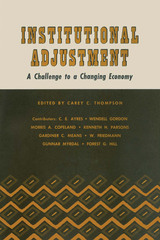 Institutional Adjustment: A Challenge to a Changing Economy
Edited by Carey C. Thompson
University of Texas Press, 1967 This collection of essays presents a stimulating and challenging examination of the nature of institutional adjustment, its history and its future, its problems and its purposes. The focus is on the pioneer work done by the late Clarence Ayres, of the University of Texas, in the study of the processes of change and growth and the nature of modern industrialized economies. The opening essay, a provocative discussion of “The Theory of Institutional Adjustment,” is Ayres’s contribution. The succeeding essays examine several aspects of institutional adjustment: - Kenneth H. Parsons discusses “The Institutional Basis of a Progressive Approach to Economic Development.”
- Wendell Gordon considers “Orthodox Economics and Institutionalized Behavior.”
- Gunnar Myrdal brings the breadth of his knowledge of many different economies and the institutional contexts within which they operate to a study of the “Adjustment of Economic Institutions in Contemporary America.”
- Forest Hill provides a historical survey of the process of growth and change in his essay “The Government and Institutional Adjustment: The American Experience.”
- Wolfgang Friedmann discusses some legal aspects of the subject in “Creative Legal Interpretation and the Process of Institutional Adjustment.”
- Rounding out this collection of essays, Morris A. Copeland and Gardiner C. Means offer proposals for guiding adjustment and change in specific areas: “Implementing the Objective of Full Employment in Our Free Enterprise System” and “Monetary Institutions to Serve the Modern Economy.”
These essays were originally read at a conference sponsored by the Department of Economics of the University of Texas at Austin in April and May of 1965.
 Institutional Change and Healthcare Organizations: From Professional Dominance to Managed Care
W. Richard Scott, Martin Ruef, Peter J. Mendel, and Carol A. Caronna
University of Chicago Press, 2000 Few large institutions have changed as fully and dramatically as the U.S. healthcare system since World War II. Compared to the 1930s, healthcare now incorporates a variety of new technologies, service-delivery arrangements, financing mechanisms, and underlying sets of organizing principles.
This book examines the transformations that have occurred in medical care systems in the San Francisco Bay area since 1945. The authors describe these changes in detail and relate them to both the sociodemographic trends in the Bay Area and to shifts in regulatory systems and policy environments at local, state, and national levels. But this is more than a social history; the authors employ a variety of theoretical perspectives—including strategic management, population ecology, and institutional theory—to examine five types of healthcare organizations through quantitative data analysis and illustrative case studies.
Providing a thorough account of changes for one of the nation's leading metropolitan areas in health service innovation, this book is a landmark in the theory of organizations and in the history of healthcare systems.
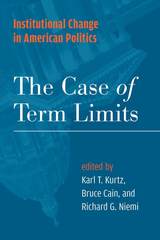 Institutional Change in American Politics: The Case of Term Limits
Edited by Karl T. Kurtz, Bruce Cain, and Richard G. Niemi
University of Michigan Press, 2009 Legislative term limits adopted in the 1990s are in effect in fifteen states today. This reform is arguably the most significant institutional change in American government of recent decades. Most of the legislatures in these fifteen states have experienced a complete turnover of their membership; hundreds of experienced lawmakers have become ineligible for reelection, and their replacements must learn and perform their jobs in as few as six years. Now that term limits have been in effect long enough for both their electoral and institutional effects to become apparent, their consequences can be gauged fully and with the benefit of hindsight. In the most comprehensive study of the subject, editors Kurtz, Cain, and Niemi and a team of experts offer their broad evaluation of the effects term limits have had on the national political landscape. "The contributors to this excellent and comprehensive volume on legislative term limits come neither to praise the idea nor to bury it, but rather to speak dispassionately about its observed consequences. What they find is neither the horror story of inept legislators completely captive to strong governors and interest groups anticipated by the harshest critics, nor the idyll of renewed citizen democracy hypothesized by its more extreme advocates. Rather, effects have varied across states, mattering most in the states that were already most professionalized, but with countervailing factors mitigating against extreme consequences, such as a flight of former lower chamber members to the upper chamber that enhances legislative continuity. This book is must reading for anyone who wants to understand what happens to major institutional reforms after the dust has settled."
---Bernard Grofman, Professor of Political Science and Adjunct Professor of Economics, School of Social Sciences, University of California, Irvine "A decade has passed since the first state legislators were term limited. The contributors to this volume, all well-regarded scholars, take full advantage of the distance afforded by this passage of time to explore new survey data on the institutional effects of term limits. Their book is the first major volume to exploit this superb opportunity."
---Peverill Squire, Professor, Department of Political Science, University of Iowa Karl T. Kurtz is Director of the Trust for Representative Democracy at the National Conference of State Legislatures. Bruce Cain is Heller Professor of Political Science and Director of the Institute of Governmental Studies at the University of California at Berkeley, and the Director of the University of California Washington Center. Richard G. Niemi is Don Alonzo Watson Professor of Political Science at the University of Rochester.
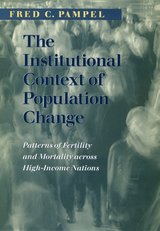 The Institutional Context of Population Change: Patterns of Fertility and Mortality across High-Income Nations
Fred C. Pampel
University of Chicago Press, 2001 Despite having similar economies and political systems, high-income nations show persistent diversity. In this pioneering work, Fred C. Pampel looks at fertility, suicide, and homicide rates in eighteen high-income nations to show how they are affected by institutional structures. European nations, for example, offer universal public benefits for men and women who are unable to work and have policies to ease the burdens of working mothers. The United States, in contrast, does not. This study demonstrates how public policy differences such as these affect childbearing among working women, moderate pressures for suicide and homicide among the young and old, and shape sex difference in suicide and homicide.
The Institutional Context of Population Change cuts across numerous political and sociological topics, including political sociology, stratification, sex and gender, and aging. It persuasively shows the importance of public policies for understanding the demographic consequences of population change and the importance of demographic change for understanding the consequences of public policies.
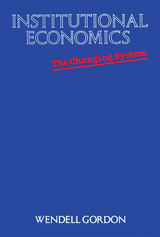 Institutional Economics: The Changing System
By Wendell Gordon
University of Texas Press, 1980 Wendell Gordon presents the philosophy of economic institutionalism clearly and evocatively, in the tradition of the pragmatism of Peirce, James, and Dewey. In Gordon's view, the institutionalism of Veblen and Ayres, the only indigenous American school of economic thought, offered the most hope for understanding and solving the economic problems of the twentieth century. The institutional approach—long known as the Texas School—looks at social order as ongoing process. The effort to explain how our attitudes have developed and how they are changed is central to this approach. Gordon argues that the dynamics of technical change, the institutionalism of behavior norms, human biology, and the resource endowment of the universe interact to create and change these attitudes. Gordon thoroughly analyzes both orthodox and Marxist economic approaches with regard to institutional economics. He also examines such other radical approaches as underconsumption and the single tax. There is a discussion of the procedures and problems involved in testing for the validity of institutional theory and the analysis of economic problems in the institutional frame of reference. In addition, inflation, energy, multinationals, property rights, business organization, unemployment, and other issues are considered from an institutional perspective.
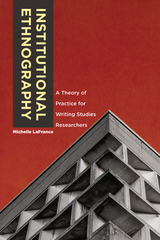 Institutional Ethnography: A Theory of Practice for Writing Studies Researchers
Michelle LaFrance
Utah State University Press, 2019 A form of critical ethnography introduced to the social sciences in the late 1990s, institutional ethnography uncovers how things happen within institutional sites, providing a new and flexible tool for the study of how “work” is co-constituted within sites of writing and writing instruction. The study of work and work processes reveals how institutional discourse, social relations, and norms of professional practice coordinate what people do across time and sites of writing. Adoption of IE offers finely grained understandings of how our participation in the work of writing, writing instruction, and sites of writing gives material face to the institutions that govern the social world.
In this book, Michelle LaFrance introduces the theories, rhetorical frames, and methods that ground and animate institutional ethnography. Three case studies illustrate key aspects of the methodology in action, tracing the work of writing assignment design in a linked gateway course, the ways annual reviews coordinate the work of faculty and writing center administrators and staff, and how the key term “information literacy” socially organizes teaching in a first-year English program. Through these explorations of the practice of ethnography within sites of writing and writing instruction, LaFrance shows that IE is a methodology keenly attuned to the material relations and conditions of work in twenty-first-century writing studies contexts, ideal for both practiced and novice ethnographers who seek to understand the actualities of social organization and lived experience in the sites they study.
Institutional Ethnography expands the field’s repertoire of research methodologies and offers the grounding necessary for work with the IE framework. It will be invaluable to writing researchers and students and scholars of writing studies across the spectrum—composition and rhetoric, literacy studies, and education—as well as those working in fields such as sociology and cultural studies.
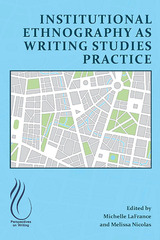 Institutional Ethnography as Writing Studies Practice
Michelle LaFrance
University Press of Colorado, 2024 The editors and contributors to this collection offer insights into the use of institutional ethnography for three primary purposes: to investigate and interrogate the cultures of work that are of interest to writing studies researchers, to understand more deeply what constitutes this work, and to consider how work takes shape within institutional contexts. Building on prior conversations about institutional ethnography, critical ethnography, and the complexities of writing programs, the editors and chapter authors consider their application to sites of writing and writing instruction. In doing so, they reveal the power of material conditions, institutional and field-based values, and the cultures of writing to shape how people carry out their everyday work in writing programs and other venues in which writing plays a central role. The findings shared in this edited collection provide insights into how institutional ethnography as a form of inquiry can make important contributions to the fields’ many ongoing conversations about the nature of our work, labor, and other writing-related interests.
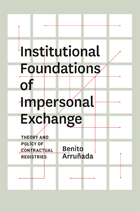 Institutional Foundations of Impersonal Exchange: Theory and Policy of Contractual Registries
Benito Arruñada
University of Chicago Press, 2012 Governments and development agencies spend considerable resources building property and company registries to protect property rights. When these efforts succeed, owners feel secure enough to invest in their property and banks are able use it as collateral for credit. Similarly, firms prosper when entrepreneurs can transform their firms into legal entities and thus contract more safely. Unfortunately, developing registries is harder than it may seem to observers, especially in developed countries, where registries are often taken for granted. As a result, policies in this area usually disappoint.
Benito Arruñada aims to avoid such failures by deepening our understanding of both the value of registries and the organizational requirements for constructing them. Presenting a theory of how registries strengthen property rights and reduce transaction costs, he analyzes the major trade-offs and proposes principles for successfully building registries in countries at different stages of development. Arruñada focuses on land and company registries, explaining the difficulties they face, including current challenges like the subprime mortgage crisis in the United States and the dubious efforts made in developing countries toward universal land titling. Broadening the account, he extends his analytical framework to other registries, including intellectual property and organized exchanges of financial derivatives. With its nuanced presentation of the theoretical and practical implications, Institutional Foundations of Impersonal Exchange significantly expands our understanding of how public registries facilitate economic growth.
Institutional Foundations of Public Finance: Economic and Legal Perspectives
Alan J. Auerbach
Harvard University Press, 2009 Institutional Foundations of Public Finance integrates economic and legal perspectives on taxation and fiscal policy, offering a provocative assessment of the most important issues in public finance today.
Part I, an in-depth look at the tax reform debate, examines the differences between an income and a consumption tax and poses significant questions about the systematic transition from one to the other, as well as about its implementation. Part II takes a focused look at a broad range of fiscal topics, including fiscal federalism, corporate finance, and fiscal language. As a whole, the volume reflects a keen interest in analyzing real-world problems, including fiscal regimes and institutions, that have major policy implications.
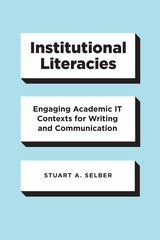 Institutional Literacies: Engaging Academic IT Contexts for Writing and Communication
Stuart A. Selber
University of Chicago Press, 2020 Information technologies have become an integral part of writing and communication courses, shaping the ways students and teachers think about and do their work. But, too often, teachers and other educational stakeholders take a passive or simply reactive role in institutional approaches to technologies, and this means they are missing out on the chance to make positive changes in their departments and on campus.
Institutional Literacies argues that writing and communication teachers and program directors should collaborate more closely and engage more deeply with IT staff as technology projects are planned, implemented, and expanded. Teachers need to both analyze how their institutions approach information technologies and intervene in productive ways as active university citizens with relevant expertise. To help them do so, the book offers a three-part heuristic, reflecting the reality that academic IT units are complex and multilayered, with historical, spatial, and textual dimensions. It discusses six ways teachers can intervene in the academic IT work of their own institutions: maintaining awareness, using systems and services, mediating for audiences, participating as user advocates, working as designers, and partnering as researchers. With these strategies in hand, educators can be proactive in helping institutional IT approaches align with the professional values and practices of writing and communication programs.
The Institutional Power of Chosŏn Korea's Queen Dowagers
Alban Schmid
Arc Humanities Press, 2024
Power in the Chosŏn dynasty of Korea (1392–1910) was shared amongst various political actors, often including female heads of royal households, namely queen dowagers. Following a diachronic approach, several case studies are examined to illustrate the extent and limits of the queen dowagers’ authority. Evidence shows that queen dowagers grew more confident and more influential over the course of the dynasty, especially as more precedents concerning their exercise of power were added to the dynasty’s Veritable Records. While queen dowagers usually refrained from getting involved in day-to-day politics, some had the power to order the dethronement of not one, but two Korean kings and, by the nineteenth century, often ruled themselves during extensive periods of regency.
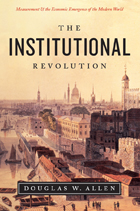 The Institutional Revolution: Measurement and the Economic Emergence of the Modern World
Douglas W. Allen
University of Chicago Press, 2011 Few events in the history of humanity rival the Industrial Revolution. Following its onset in eighteenth-century Britain, sweeping changes in agriculture, manufacturing, transportation, and technology began to gain unstoppable momentum throughout Europe, North America, and eventually much of the world—with profound effects on socioeconomic and cultural conditions. In The Institutional Revolution, Douglas W. Allen offers a thought-provoking account of another, quieter revolution that took place at the end of the eighteenth century and allowed for the full exploitation of the many new technological innovations. Fundamental to this shift were dramatic changes in institutions, or the rules that govern society, which reflected significant improvements in the ability to measure performance—whether of government officials, laborers, or naval officers—thereby reducing the role of nature and the hazards of variance in daily affairs. Along the way, Allen provides readers with a fascinating explanation of the critical roles played by seemingly bizarre institutions, from dueling to the purchase of one’s rank in the British Army. Engagingly written, The Institutional Revolution traces the dramatic shift from premodern institutions based on patronage, purchase, and personal ties toward modern institutions based on standardization, merit, and wage labor—a shift which was crucial to the explosive economic growth of the Industrial Revolution.
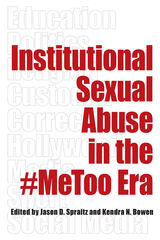 Institutional Sexual Abuse in the #MeToo Era
Edited by Jason D. Spraitz and Kendra N. Bowen
Southern Illinois University Press, 2021 Examining the evolving reach of the #MeToo Movement
In this timely and important collection, editors Jason D. Spraitz and Kendra N. Bowen bring together the work of contributors in the fields of criminal justice and criminology, sociology, journalism, and communications. These chapters show #MeToo is not only a support network of victims’ voices and testimonies but also a revolutionary interrogation of policies, power imbalances, and ethical failures that resulted in decades-long cover-ups and institutions structured to ensure continued abuse. This book reveals #MeToo as so much more than a hashtag.
Contributors discuss how #MeToo has altered the landscape of higher education; detail a political history of sexual abuse in the United States and the UK; discuss a recent grand jury report about religious institutions; and address the foster care and correctional systems. Hollywood instances are noted for their fear of retaliation among victims and continued accolades for alleged abusers. In sports, contributors examine the Jerry Sandusky scandal and the abuse by Larry Nassar. Advertising and journalism are scrutinized for covering the #MeToo disclosures while dealing with their own scandals. Finally, social media platforms are investigated for harassment and threats of violent victimization. Drawing on the general framework of the #MeToo Movement, contributors look at complex and very different institutions—athletics, academia, religion, politics, justice, childcare, social media, and entertainment. Contributors include revelatory case studies to ensure we hear the victims’ voices; bring to light the complicity and negligence of social institutions; and advocate for systemic solutions to institutional sexual abuse, violence, and harassment.
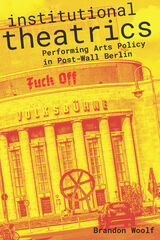 Institutional Theatrics: Performing Arts Policy in Post-Wall Berlin
Brandon Woolf
Northwestern University Press, 2021 Shortlist, 2021 Waterloo Centre for German Studies Book Prize
2022 Outstanding Book Award Finalist from the Association for Theater in Higher Education (ATHE)
In a city struggling to determine just how neoliberal it can afford to be, what kinds of performing arts practices and institutions are necessary—and why?
Since the fall of the Berlin Wall, political and economic agendas in the reunified German capital have worked to dismantle long-standing traditions of state‑subsidized theater even as the city has redefined itself as a global arts epicenter. Institutional Theatrics charts the ways theater artists have responded to these shifts and crises both on- and offstage, offering a method for rethinking the theater as a vital public institution.
What is the future of the German theater, grounded historically in large ensembles, extensive repertoires, and auteur directors? Examining the restructuring of Berlin’s theatrical landscape and most prominent performance venues, Brandon Woolf argues that cultural policy is not simply the delegation and distribution of funds. Instead, policy should be thought of as an artistic practice of institutional imagination. Woolf demonstrates how performance can critique its patron institutions in order to transform the relations between the stage and the state, between the theater and the infrastructures of its support. Bold, nuanced, and rigorously documented, Institutional Theatrics offers new insights about art, its administration, and the forces that influence cultural production.
Institutional trust and economic policy Lessons from the history of the Euro: Lessons from the history of the Euro
Dóra Gyorffy
Central European University Press, 2013 The book seeks to link theoretical debates on the relevance of trust in economic outcomes with the current arguments about the origins and lessons of the subprime crisis. By what mechanisms does trust influence economic outcomes? Under what conditions do these mechanisms prevail? How do debates about trust help our understanding of the subprime crisis in the European Union? By integrating insights from Post-Keynesian, Austrian and new institutional economics, the central proposition of the analysis is that the presence or absence of institutional trust creates virtuous and vicious cycles in law-abiding, which critically influence the possibility for economic agents to have realistic long-term plans.
The Institutionalisation of Political Parties in Post-authoritarian Indonesia: From the Grass-roots Up
Ulla Fionna
Amsterdam University Press, 2013 Indonesia’s democratic political parties developed rapidly after the end of the New Order era (1966–1998). Based on extensive fieldwork, this book provides a new and necessary perspective on the activities, administration, and membership of the local branches of four large parties. The author also addresses why some political parties in Indonesia have managed to strengthen their institutional base while others have failed to do the same. A significant contribution to understanding grassroots party organization in Indonesia, this timely volume provides insight into the state of parties in advance of the 2014 elections.
An Institutionalist Approach to Public Utility Regulation
Edythe S. Miller
Michigan State University Press, 2002 For the past several decades, a climate of deregulation has encompassed industries ranging from public utilities to mass transportation. Harry Martin Trebing has been at the forefront of this debate as one of the world’s foremost specialists in the field of public utility regulation. Warren J. Samuels and Edythe S. Miller have collected a series of articles that assess Trebing’s theories on public utility regulation while examining his towering contribution to the field.
 The Institutionalization of Islam in Southern Senegal: Intermarriage, Qur'anic Education, and Jihad
Aly Dramé
University of Michigan Press, 2025 Weaving together oral and written sources, The Institutionalization of Islam in Southern Senegal investigates previously overlooked dimensions of Islamization in Senegambia through the processes of intermarriage, Qur’anic education, and jihãd. Due to its geographic location at the point where Senegal, The Gambia, and Guinea-Bissau meet, the Middle Casamance has historically been a melting pot where centralized and decentralized societies have coexisted for generations. In the past, historians have failed to consider the contributions of the Middle Casamance region and Mandinka Muslim settlements to the development of Islam, despite centers for Islamic education having existed in the region centuries before the emergence of the Sufi and jihãd movements of the eighteenth and nineteenth centuries. Aly Dramé seeks to close this gap by conceptualizing the leading role played by these Mandinka settlements and how religious spaces are negotiated, acquired, and transformed through intermarriage, Qur’anic education, and jihãd when peoples from distinct backgrounds encounter one another.
Drawing on archival documents, oral history and traditions, travelers’ accounts, the Arabic text Pakao al-Qurano (Holy Book of Pakao), and original ethnography, The Institutionalization of Islam in Southern Senegal demonstrates how these communities reframe the debates about the institutionalization of Islam in Senegambia geographically, chronologically, and thematically.
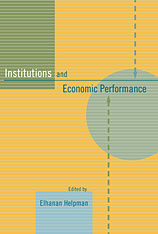 Institutions and Economic Performance
Elhanan Helpman
Harvard University Press, 2008 Institutions and Economic Performance explores the question of why income per capita varies so greatly across countries. Even taking into account disparities in resources, including physical and human capital, large economic discrepancies remain across countries. Why are some societies but not others able to encourage investments in places, people, and productivity?
The answer, the book argues, lies to a large extent in institutional differences across societies. Such institutions are wide-ranging and include formal constitutional arrangements, the role of economic and political elites, informal institutions that promote investment and knowledge transfer, and others. Two core themes run through the contributors’ essays. First, what constraints do institutions place on the power of the executive to prevent it from extorting the investments and effort of other people and institutions? Second, when are productive institutions self-enforcing?
Institutions and Economic Performance is unique in its melding of economics, political science, history, and sociology to address its central question.
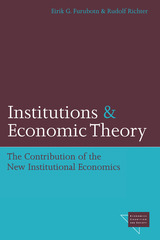 Institutions and Economic Theory: The Contribution of the New Institutional Economics
Eirik Furubotn and Rudolf Richter
University of Michigan Press, 2005 This second edition assesses some of the major refinements, extensions, and useful applications that have developed in neoinstitutionalist thought in recent years. More attention is given to the overlap between the New Institutional Economics and developments in economic history and political science. In addition to updated references, new material includes analysis of parallel developments in the field of economic sociology and its attacks on representatives of the NIE as well as an explanation of the institution-as-an-equilibrium-of-game approach. Already an international best seller, Institutions and Economic Theory is essential reading for economists and students attracted to the NIE approach. Scholars from such disciplines as political science, sociology, and law will find the work useful as the NIE continues to gain wide academic acceptance. A useful glossary for students is included. Eirik Furubotn is Honorary Professor of Economics, Co-Director of the Center for New Institutional Economics, University of Saarland, Germany and Research Fellow, Private Enterprise Research Center, Texas A&M University. Rudolph Richter is Professor Emeritus of Economics and Director of the Center for New Institutional Economics, University of Saarland, Germany.
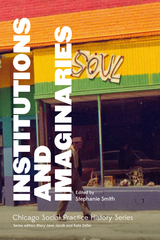 Institutions and Imaginaries
Edited by Stephanie Smith
School of the Art Institute of Chicago, 2014 Socially engaged art, though its transformative practice, shapes the institutions that surround it. And in a city famous for both its physical and political structures, few creative communities are as deeply intertwined with a city’s framework than those in Chicago.
This volume focuses on how artists and others have worked with, within, and sometimes in opposition to large Chicago institutions, such as public schools, universities, libraries, archives, museums, and other civic bodies. Drawing from a broad range of interdisciplinary sources, it explores the far-reaching effect of socially motivated art on urban life. It grounds recent history within a longer arc of civic self-fashioning, from the Columbian Exposition of 1893 to Jane Addams's Hull House to John Dewey's legacy in arts education. The collection also examines the relationship between the city’s image and the types of artistic work that flourish within its boundaries and resonate far beyond them.
Institutions and Imaginaries is part of the new Chicago Social Practice History series, edited by Mary Jane Jacob and Kate Zeller in the Department of Exhibitions and Exhibition Studies at the School of the Art Institute of Chicago (SAIC).
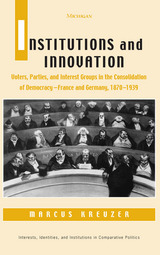 Institutions and Innovation: Voters, Parties, and Interest Groups in the Consolidation of Democracy - France and Germany, 1870-1939
Marcus Kreuzer
University of Michigan Press, 2001 If all parties need votes to get elected, why do some parties court voters more ardently than others? To answer this question, the book analyzes how political institutions determine the degree to which parties behave as entrepreneurial agents of voters or as inert, bureaucratic behemoths and how different levels of party responsiveness affect democratic consolidation.
Institutions and Innovations analyzes the troubled history of French and German parties between 1870 and 1939 to develop a general explanation of how the development of responsive parties constitutes a key element for the consolidation of democracies, past and present. It explains why French parties responded more swiftly than German ones to very similar changes in their economic and political environments. The book demonstrates that the national differences in party responsiveness played a key role in the collapse of the German Weimar Republic (1918ñ1933) and in the survival of the French Third Republic (1870ñ1939). It addresses the general fates of French and German democracy by asking three specific questions: Why did German socialists reject Keynesianism while their French counterparts swiftly embraced it? Why did German liberals, compared to French ones, fail to modernize their logistical infrastructure and electioneering methods? Why were German conservatives less effective than French ones in fending off the challenge posed by fascist and peasant insurgent movements that arose in the 1920s and 1930s?
In answering these questions, the book engages new institutional theories and longstanding party literature to demonstrate that the electoral conduct of parties is structured in equal parts by socioeconomic and institutional constraints. The book's interdisciplinary focus sheds a critical light on the exceptionalism of purely historical accounts and reductionist and universal claims of ahistorical political science theories.
Marcus Kreuzer is Assistant Professor of Political Science, Villanova University.
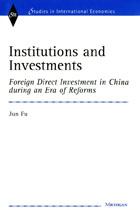 Institutions and Investments: Foreign Direct Investment in China during an Era of Reforms
Jun Fu
University of Michigan Press, 2000 As China continues to be heralded as a rising economic power, the need for an understanding of its institutional effects--such as investment-related policies, regulations, and laws--on foreign direct investment increases as well. Institutions and Investments employs interdisciplinary perspectives from economics, business, law, and political science to shed light on the interaction between institutional changes and investment patterns and to form a clear picture of investment behavior as China's legal and regulatory infrastructure has developed over the reform years.
Organized into three main parts, the book first discusses the evolution and nature of China's FDI regulatory framework. Part 2 examines the various modes and variant patterns of FDI in China in the reform years. Part 3's central task is to demonstrate a systematic link between institutional changes in China's FDI regulatory framework and the changing patterns of FDI. In conclusion, Jun Fu finds that China has made substantial progress from a command economy to a market system, but that it still has a long way to go before it truly attains a transparent and rule-based system.
This book adds new dimensions to the scholarship on China as a growing economic power and will be of particular interest to international economists, political scientists, and business scholars studying China.
Jun Fu is Associate Professor in the School of Economics and Management, Tsinghua University.
 Institutions and Social Order
Karol Soltan, Virginia Haufler, and Eric M. Uslaner, Editors
University of Michigan Press, 1998 "Institutionalism" is the buzzword of the 1980s and 1990s in the social sciences. What is new in the contemporary analysis of institutions and what does it offer to the study of social order? In this book a distinguished group of social scientists drawn from political science, economics, and sociology, explore this question and show us how different theoretical approaches to institutional analysis can be joined to build a more thorough understanding of institutions. The modern analysis of institutions has taken two separate paths. Rational choice theories identified institutions as a strategic response to collective action problems and as instruments for the promotion of cooperation. Contrary to these theories, such cooperation is fundamental to social order and a prerequisite for economic growth and development. An alternate form of institutionalism, drawn from sociological and historical analysis, de-emphasized the role of choice, strategy, and design in the construction of many of the major institutions in social life. This form of institutional analysis pointed to the role of prior choices, common norms, and culture in making certain options and choices unthinkable or impossible. Institutions, according to this view, may represent a certain kind of social order, but they do not always promote cooperation and economic growth.The more recent theories in the "new institutionalism" bring these seemingly irreconcilable perspectives closer together. New institutionalists argue that institutions must be grounded in the social fabric, and thus rational choice must be combined with historical and cultural variables. The papers collected in this volume address the merging of rational choice and historical-sociological institutionalism in the "new institutionalism." Institutions and Social Order offer a conversation that enables us to explore the commonalities -- and divisions -- between the disciplies and the ways these disciplines define and use institutions in their analysis. The contributors include Randall L. Calvert, Christopher Clague, Kathleen Cook, Peter A. Hall, Virginia Haufler, Gary Miller, Karol Soltan, Rosemary C. R. Taylor, Eric M. Uslaner, and Barry R. Weingast.
Institutions And The Fate Of Democracy: Germany And Poland In The Twentieth Century
Michael Bernhard
University of Pittsburgh Press, 2005
As democracy has swept the globe, the question of why some democracies succeed while others fail has remained a pressing concern. In this theoretically innovative, richly historical study, Michael Bernhard looks at the process by which new democracies choose their political institutions, showing how these fundamental choices shape democracy's survival.
Offering a new analytical framework that maps the process by which basic political institu-tions emerge, Bernhard investigates four paradigmatic episodes of democracy in two countries: Germany during the Weimar period and after World War II, and Poland between the world wars and after the fall of communism.
Students of democracy will appreciate the broad applicability of Bernhard's findings, while area specialists will welcome the book's accessible and detailed historical accounts.
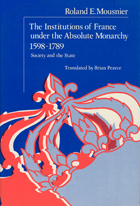 The Institutions of France under the Absolute Monarchy, 1598-1789, Volume 1: Society and the State
Roland Mousnier
University of Chicago Press, 1979 Political and administrative institutions cannot be understood unless one knows who is operating them and for whose benefit they function. In the first volume of this history, Mousnier analyzes such institutions in light of the prevailing social, economic, and ideological structures and shows how they shaped life in 17th- and 18th-century France. He traces the changing role of monarchical government, showing how it emerged over two centuries and why it failed.
In a society divided by hierarchical social groups, conflicts among lineages, communities, and districts became inevitable. Aristocratic disdain, ancestral attachment to privileges, and autonomous powers looked upon as rights, made civil unrest, dislocation, and anarchy endemic. Mousnier examines this contention between classes as they faced each other across the institutional barriers of education, religion, economic resources, technology, means of defense and communication, and territorial and family ties. He shows why a monarchical state was necessary to preserve order within this fragmented society.
Though it was intent on ensuring the survival of French society and the public good, the Absolute Monarchy was unable to maintain security, equilibrium, and cooperation among rival social groups. Discussing the feeble technology at its disposal and its weak means of governing, Mousnier points to the causes that brought the state to the limits of its resources. His comprehensive analysis will greatly interest students of the ancien régime and comparativists in political science and sociology as well.
The Institutions of France under the Absolute Monarchy, 1598-1789, Volume 2: The Origins of State and Society
Roland Mousnier
University of Chicago Press, 1984 Mousnier continues his massive and masterly history of France's transition from the Old Regime to the New. Mousnier's subject is the organization of the state, from the Council at the summit to the most humble clerks, guards, and attendants. He traces the gradual transformation of France from a judiciary state to a financial and executive bureaucracy, from a state and society based on hereditary statuses to one based on talents, personal capacities, and achievements, from the might of the sword to the power of the pen.
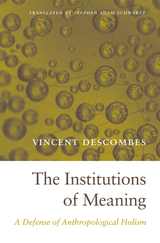 The Institutions of Meaning: A Defense of Anthropological Holism
Vincent Descombes
Harvard University Press, 2014 Holism grows out of the philosophical position that an object or phenomenon is more than the sum of its parts. And yet analysis--a mental process crucial to human comprehension--involves breaking something down into its components, dismantling the whole in order to grasp it piecemeal and relationally. Wading through such quandaries with grace and precision, The Institutions of Meaning guides readers to a deepened appreciation of the entity that ultimately enables human understanding: the mind itself.
This major work from one of France's most innovative philosophers goes against the grain of analytic philosophy in arguing for the view known as anthropological holism. Meaning is not fundamentally a property of mental representations, Vincent Descombes says. Rather, it arises out of thought that is holistic, embedded in social existence, and bound up with the common practices that shape the way we act and talk.
To understand what an individual "believes" or "wants"--to apply psychological words to a person--we must take into account the full historical and institutional context of a person's life. But how can two people share the same thought if they do not share the same system of belief? Descombes solves this problem by developing a logic of relations that explains the ability of humans to analyze structures based on their parts. Integrating insights from anthropology, linguistics, and social theory, The Institutions of Meaning pushes philosophy forward in bold new directions.
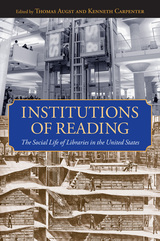 Institutions of Reading: The Social Life of Libraries in the United States
Thomas Augst
University of Massachusetts Press, 2007 Tracing the evolution of the library as a modern institution from the late eighteenth century to the digital era, this book explores the diverse practices by which Americans have shared reading matter for instruction, edification, and pleasure. Writing from a rich variety of perspectives, the contributors raise important questions about the material forms and social shapes of American culture. What is a library? How have libraries fostered communities of readers and influenced the practice of reading in particular communities? How did the development of modern libraries alter the boundaries of individual and social experience, and define new kinds of public culture? To what extent have libraries served as commercial enterprises, as centers of power, and as places of empowerment for African Americans, women, and immigrants? Institutions of Reading offers at once a social history of literacy and leisure, an intellectual history of institutional and technological innovations that facilitated the mass distribution and consumption of printed books and periodicals, and a cultural history of the symbolic meanings and practical uses of reading in American life. In addition to the editors, contributors include Elizabeth Amann, Michael Baenen, James Green, Elizabeth McHenry, Barbara Mitchell, Christine Pawley, Janice Radway, James Raven, Karin Roffman, and Roy Rosenzweig.
The Institutions of Russian Modernism: Conceptualizing, Publishing, and Reading Symbolism
Jonathan Stone
Northwestern University Press, 2017 The Institutions of Russian Modernism illuminates the key role of Symbolism as the earliest form of modernism in Russia, emerging seemingly ex nihilo at the end of the nineteenth century. Combining book history, periodical studies, and reception theory, Jonathan Stone examines the poetry and theory of Russian Symbolism within the framework of the institutions that organized, published, and disseminated the works to Russian readers. Surveying a wealth of examples of books, journals, and almanacs, Stone traces how publishers of Symbolist works marketed the movement and fashioned a Symbolist reader. His persuasive argument that after its eclipse Symbolism's legacy remained embedded in the heart of Russian modernism will be of interest to scholars and general readers.
Instream Flow Protection: Seeking A Balance In Western Water Use
David M. Gillilan and Thomas C. Brown
Island Press, 1997 Instream Flow Protection is a comprehensive overview of Western water use and the issues that surround it. The authors explain instream flow and its historical, political, and legal context; describe current instream flow laws and policies; and present methods of protecting instream flow. They provide numerous examples to illustrate their discussions, with case studies of major river systems including the Bitterroot, Clark's Fork, Colorado, Columbia, Mimbres, Mono Lake, Platte, Snake, and Wind. Policymakers, land and water managers at local, state, and federal levels, attorneys, students and researchers of water issues, and anyone concerned with instream flow protection will find the book enormously valuable.
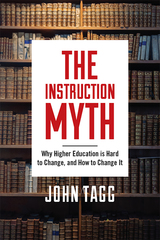 The Instruction Myth: Why Higher Education is Hard to Change, and How to Change It
John Tagg
Rutgers University Press, 2019 Higher education is broken, and we haven’t been able to fix it. Even in the face of great and growing dysfunction, it seems resistant to fundamental change. At this point, can anything be done to save it?
The Instruction Myth argues that yes, higher education can be reformed and reinvigorated, but it will not be an easy process. In fact, it will require universities to abandon their central operating principle, the belief that education revolves around instruction, easily measurable in course syllabi, credits, and enrollments. Acclaimed education scholar John Tagg presents a powerful case that instruction alone is worthless and that universities should instead be centered upon student learning, which is far harder to quantify and standardize. Yet, as he shows, decades of research have indicated how to best promote student learning, but few universities have systematically implemented these suggestions.
This book demonstrates why higher education must undergo radical change if it hopes to survive. More importantly, it offers specific policy suggestions for how universities can break their harmful dependence on the instruction myth. In this extensively researched book, Tagg offers a compelling diagnosis of what’s ailing American higher education and a prescription for how it might still heal itself.
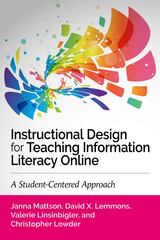 Instructional Design for Teaching Information Literacy Online: A Student-Centered Approach
Janna Mattson
Association of College & Research Libraries, 2025 Demand for online classes in higher education is growing. And whether you’re a seasoned library instructor adapting to more online instruction or a new librarian learning about instruction for the first time, you’re probably expected to be equally skilled in both face-to-face and online classrooms. Instructional Design for Teaching Information Literacy Online: A Student-Centered Approach introduces light-hearted tips and advice with author-curated playlists and practical tips on rapidly designing online instruction. It offers scenarios, learning activities, lesson plan examples, rubrics, worksheets, and more, using the classic instructional design model ADDIE to frame the process and the universal design for learning framework, the community of inquiry model, and asset-based pedagogy to address the social and emotional needs of diverse online learners. Six parts offer a theoretical grounding, practical resources, and the enhanced confidence and skills needed to create successful learning experiences. - Foundational Knowledge
- Analysis
- Design
- Development
- Implementation
- Evaluation
Online learning can be an opportunity to extend our reach and connection to our students and help them learn what they need to succeed. Instructional Design for Teaching Information Literacy Online provides a learner-centered approach to online instruction for both students and teachers.
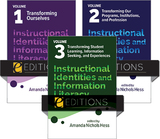 Instructional Identities and Information Literacy: Three Volume Set
Amanda Nichols Hess
Association of College & Research Libraries, 2023 Are librarians teachers? Many academic librarians enter teaching roles with limited experience or education in instruction, discovering how to engage students in learning from their own observations, trial-and-error, or professional learning opportunities. Grappling with this potentially unexpected identity comes amid a time of significant transition for higher education itself. Academic librarians must figure out how to counter mis-, dis-, and malinformation, address shrinking funding for collections while costs increase, and establish meaningful partnerships in diverse, data-driven environments. And writ large, librarianship as a profession continues to grapple with its responsibility to challenge information illiteracy across contexts, its support of systemic systems of oppression under the guise of neutrality, and its value to a society flooded with information. In three volumes, Instructional Identities and Information Literacy uses transformative learning theory—a way of understanding adult learning and ourselves—to explore the ways librarians can meaningfully advance how we think about our identities, instructional work, and learning as transformation. Three volumes explore: - Transforming Ourselves
- Transforming Our Programs, Institutions, and Profession
- Transforming Student Learning, Information Seeking, and Experiences
Chapters include transforming a critical, feminist pedagogy with antiracist pedagogy; becoming an advocate for library instruction to promote student success; the intersection of reluctant professionals and the academy; transforming STEM learning and information-seeking experiences; using the Framework to reshape student responses to media narratives; and much more. Instructional Identities and Information Literacy contains many ways to consider the programming, dispositions, behaviors, and attitudes we can use as we continue to advance information literacy instruction and reshape our profession.
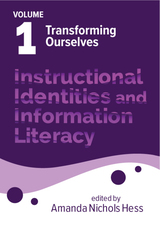 Instructional Identities and Information Literacy: Volume 1: Transforming Ourselves
Amanda Nichols Hess
Association of College & Research Libraries, 2023 Are librarians teachers? Many academic librarians enter teaching roles with limited experience or education in instruction, discovering how to engage students in learning from their own observations, trial-and-error, or professional learning opportunities. Grappling with this potentially unexpected identity comes amid a time of significant transition for higher education itself. Academic librarians must figure out how to counter mis-, dis-, and malinformation, address shrinking funding for collections while costs increase, and establish meaningful partnerships in diverse, data-driven environments. And writ large, librarianship as a profession continues to grapple with its responsibility to challenge information illiteracy across contexts, its support of systemic systems of oppression under the guise of neutrality, and its value to a society flooded with information. In three volumes, Instructional Identities and Information Literacy uses transformative learning theory—a way of understanding adult learning and ourselves—to explore the ways librarians can meaningfully advance how we think about our identities, instructional work, and learning as transformation. Three volumes explore: - Transforming Ourselves
- Transforming Our Programs, Institutions, and Profession
- Transforming Student Learning, Information Seeking, and Experiences
Chapters include transforming a critical, feminist pedagogy with antiracist pedagogy; becoming an advocate for library instruction to promote student success; the intersection of reluctant professionals and the academy; transforming STEM learning and information-seeking experiences; using the Framework to reshape student responses to media narratives; and much more. Instructional Identities and Information Literacy contains many ways to consider the programming, dispositions, behaviors, and attitudes we can use as we continue to advance information literacy instruction and reshape our profession.
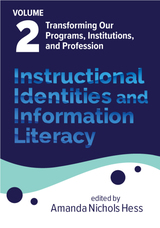 Instructional Identities and Information Literacy: Volume 2: Transforming Our Programs, Institutions, and Profession
Amanda Nichols Hess
Association of College & Research Libraries, 2023 Are librarians teachers? Many academic librarians enter teaching roles with limited experience or education in instruction, discovering how to engage students in learning from their own observations, trial-and-error, or professional learning opportunities. Grappling with this potentially unexpected identity comes amid a time of significant transition for higher education itself. Academic librarians must figure out how to counter mis-, dis-, and malinformation, address shrinking funding for collections while costs increase, and establish meaningful partnerships in diverse, data-driven environments. And writ large, librarianship as a profession continues to grapple with its responsibility to challenge information illiteracy across contexts, its support of systemic systems of oppression under the guise of neutrality, and its value to a society flooded with information. In three volumes, Instructional Identities and Information Literacy uses transformative learning theory—a way of understanding adult learning and ourselves—to explore the ways librarians can meaningfully advance how we think about our identities, instructional work, and learning as transformation. Three volumes explore: - Transforming Ourselves
- Transforming Our Programs, Institutions, and Profession
- Transforming Student Learning, Information Seeking, and Experiences
Chapters include transforming a critical, feminist pedagogy with antiracist pedagogy; becoming an advocate for library instruction to promote student success; the intersection of reluctant professionals and the academy; transforming STEM learning and information-seeking experiences; using the Framework to reshape student responses to media narratives; and much more. Instructional Identities and Information Literacy contains many ways to consider the programming, dispositions, behaviors, and attitudes we can use as we continue to advance information literacy instruction and reshape our profession.
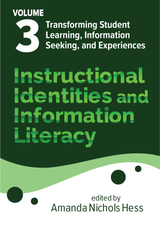 Instructional Identities and Information Literacy: Volume 3: Transforming Student Learning, Information Seeking, and Experiences
Amanda Nichols Hess
Association of College & Research Libraries, 2023 Are librarians teachers? Many academic librarians enter teaching roles with limited experience or education in instruction, discovering how to engage students in learning from their own observations, trial-and-error, or professional learning opportunities. Grappling with this potentially unexpected identity comes amid a time of significant transition for higher education itself. Academic librarians must figure out how to counter mis-, dis-, and malinformation, address shrinking funding for collections while costs increase, and establish meaningful partnerships in diverse, data-driven environments. And writ large, librarianship as a profession continues to grapple with its responsibility to challenge information illiteracy across contexts, its support of systemic systems of oppression under the guise of neutrality, and its value to a society flooded with information. In three volumes, Instructional Identities and Information Literacy uses transformative learning theory—a way of understanding adult learning and ourselves—to explore the ways librarians can meaningfully advance how we think about our identities, instructional work, and learning as transformation. Three volumes explore: - Transforming Ourselves
- Transforming Our Programs, Institutions, and Profession
- Transforming Student Learning, Information Seeking, and Experiences
Chapters include transforming a critical, feminist pedagogy with antiracist pedagogy; becoming an advocate for library instruction to promote student success; the intersection of reluctant professionals and the academy; transforming STEM learning and information-seeking experiences; using the Framework to reshape student responses to media narratives; and much more. Instructional Identities and Information Literacy contains many ways to consider the programming, dispositions, behaviors, and attitudes we can use as we continue to advance information literacy instruction and reshape our profession.
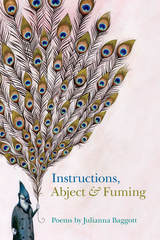 Instructions, Abject & Fuming
Julianna Baggott
Southern Illinois University Press, 2017 In this inventive collection, Julianna Baggott invites readers to reconsider basic assumptions about language, faith, motherhood, and love. With a sharply honed voice featuring parentheticals that often comment on and sometimes undercut what has come before, these poems whirl through contemporary America, engaging with topics as diverse and timely as Russian mail-order brides, Internet bullying, and school shootings.
Alongside her cultural commentary, the speaker frankly confronts love and sex, as well as the beauty and brutality of having children. Still other poems reflect questions and considerations of faith: the speaker ponders St. Thomas in a pet store and imagines Jesus explaining to God how it feels to have a body.
Baggott’s use of obsolete Old English words subverts common language and creates new ways of interrogating the world around us. There is heartache on these pages, but Baggott also offers humor, such as a complaint about a lover’s eating habits or an extended discourse on a baby’s rattle. Baggott’s latest proves to be a rollicking book sui generis.
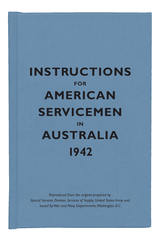 Instructions for American Servicemen in Australia, 1942
Edited by the Bodleian Library
Bodleian Library Publishing, 2006 “Unlike cricket, which is a polite game, Australian Rules Football creates a desire on the part of the crowd to tear someone apart, usually the referee.” This is only one of the entertaining and astute observations the U.S. military provided in the pocket guides distributed to the nearly one million American soldiers who landed on the shores of Australia between 1942 and 1945. Although the Land Down Under felt more familiar than many of their assignments abroad, American GIs still needed help navigating the distinctly different Aussie culture, and coming to their rescue was Instruction for American Servicemen in Australia, 1942. The newest entry in the Bodleian Library’s bestselling series of vintage pocket guides, this pamphlet is filled with pithy notes on Australian customs, language, and other cultural facts the military deemed necessary for every American soldier. From the native wildlife—a land of “funny animals”—to the nation’s colonial history to the general characteristics of Australians—“an outdoors sort of people, breezy and very democratic”—Instructions for American Servicemen in Australia gives a concise yet amazingly informative overview of the island nation. Regarding Aussie slang, it notes that “the Australian has few equals in the world at swearing. . . . The commonest swear words are ‘bastard’ (pronounced ‘barstud’), ‘bugger,’ and ‘bloody,’ and the Australians have a genius for using the latter nearly every other word.” The pamphlet also contains a humorous explanation of the country’s musical traditions—including an annotated text of “Waltzing Matilda”—as well as amusing passages on sports, politics, and the Aussies’ attitudes toward Yanks and Brits. A fascinating look at a neglected Allied front in the Southern hemisphere, Instructions for American Servicemen in Australia, 1942 follows its successful predecessors as a captivating historical document of a pivotal era in history.
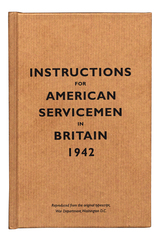 Instructions for American Servicemen in Britain, 1942: Reproduced from the original typescript, War Department, Washington, DC
Edited by the Bodleian Library
Bodleian Library Publishing, 2004 In 1942, the United States War Department distributed a handbook to American servicemen that advised them on the peculiarities of the "British, their country, and their ways." Over sixty years later, this newly published reproduction from the rich archives of the Bodleian Library offers a fascinating glimpse into American military preparations for World War II.
The guide was intended to alleviate the culture shock for soldiers taking their first trip to Great Britain, or, for that matter, abroad. The handbook is punctuated with endearingly nostalgic advice and refreshingly candid quips such as: "The British don't know how to make a good cup of coffee. You don't know how to make a good cup of tea. It's an even swap." By turns hilarious and poignant, many observations featured in the handbook remain relevant even today.
Reproduced in a style reminiscent of the era, Instructions for American Servicemen in Britain is a powerfully evocative war-time memento that offers a unique perspective on the longstanding American-British relationship and reveals amusingly incisive American perceptions of the British character and country.
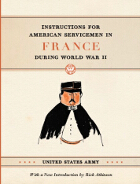 Instructions for American Servicemen in France during World War II
United States Army
University of Chicago Press, 2008 “You are about to play a personal part in pushing the Germans out of France. Whatever part you take—rifleman, hospital orderly, mechanic, pilot, clerk, gunner, truck driver—you will be an essential factor in a great effort.”
As American soldiers fanned out from their beachhead in Normandy in June of 1944 and began the liberation of France, every soldier carried that reminder in his kit. A compact trove of knowledge and reassurance, Instructions for American Servicemen in France during World War II was issued to soldiers just before they embarked for France to help them understand both why they were going and what they’d find when they got there. After lying unseen in Army archives for decades, this remarkable guide is now available in a new facsimile edition that reproduces the full text and illustrations of the original along with a new introduction by Rick Atkinson setting the book in context.
Written in a straightforward, personal tone, the pamphlet is equal parts guidebook, cultural snapshot, and propaganda piece. A central aim is to dispel any prejudices American soldiers may have about the French—especially relating to their quick capitulation in 1940. Warning soldiers that the defeat “is a raw spot which the Nazis have been riding” since the occupation began, Instructions is careful to highlight France’s long historical role as a major U.S. ally. Following that is a brief, fascinating sketch of the French character (“The French are mentally quick;” “Rich or poor, they are economical”) and stark reminders of the deprivation the French have endured under occupation. Yet an air of reassuring confidence pervades the final section of the pamphlet, which reads like a straightforward tourists’ guide to Paris and the provinces—like a promise of better days to come once the soldiers complete their mission.
Written by anonymous War Department staffers to meet the urgent needs of the moment, with no thought of its historical value, Instructionsfor American Servicemen in France during World War II nevertheless brings to vivid life the closing years of World War II—when optimism was growing, but a long, demanding road still lay ahead.
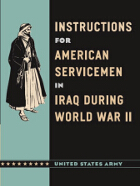 Instructions for American Servicemen in Iraq during World War II
United States Army
University of Chicago Press, 2007 “American success or failure in Iraq may well depend on whether the Iraqis like American soldiers or not.”
The U.S. military could certainly have used that bit of wisdom in 2003, as violence began to eclipse the Iraq War’s early successes. Ironically, had the Army only looked in its own archives, they would have found it—that piece of advice is from a manual the U.S. War Department handed out to American servicemen posted in Iraq back in 1943.
The advice in Instructions for American Servicemen in Iraq during World War II,presented here in a new facsimile edition, retains a surprising, even haunting, relevance in light of today’s muddled efforts to win Iraqi hearts and minds. Designed to help American soldiers understand and cope with what was at the time an utterly unfamiliar culture—the manual explains how to pronounce the word Iraq, for instance—this brief, accessible handbook mixes do-and-don’t-style tips (“Always respect the Moslem women.” “Talk Arabic if you can to the people. No matter how badly you do it, they will like it.”) with general observations on Iraqi history and society. The book’s overall message still rings true—dramatically so—more than sixty years later: treat an Iraqi and his family with honor and respect, and you will have a strong ally; treat him with disrespect and you will create an unyielding enemy.
With a foreword by Lieutenant Colonel John A. Nagl reflecting on the manual’s continuing applicability—and lamenting that it was unknown at the start of the invasion—this new edition of Instructions for American Servicemen in Iraq will be essential reading for anyone who cares about the future of Iraq and the fate of the American soldiers serving there.
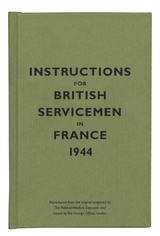 Instructions for British Servicemen in France, 1944
Edited by the Bodleian Library
Bodleian Library Publishing, 2006 When World War II drew to a close, British servicemen were sent to France to assist in the liberation and recovery of their war-ravaged ally, and a small but indispensable guidebook was packed into their knapsacks for the mission. A follow-up to the hugely successful publication of Instructions for American Servicemen in Britain, 1942, this pamphlet offers a rare and insightful glimpse into the lives of soldiers during the Second World War.
Instructions for British Servicemen in France, 1944 reminds British soldiers of the common points of culture and history Britain shares with France, and, above all, their mutual aim of defeating Hitler. The pamphlet attempts to teach British soldiers the ways of the French and warns them not give in to their urges: “If you should happen to imagine that the first pretty French girl who smiles at you intends to dance the can-can or take you to bed, you risk stirring up a lot of trouble for yourself—and for our relations with the French.” The pamphlet also features a pronunciation guide (“Bonjewer, commont-allay-voo?”), a list of useful phrases, and an unflinching account of the diseases and poverty ravaging the citizens of battle-torn France.
Instructions for British Servicemen in France, 1944 captures the complex dynamics of Anglo-French relations during the Second World War on an intimate and often humorous level and reveals all the fascinating aspects of life off the battlefield. Essential for the shelf of every historian and history buff, Instructions for British Servicemen in France, 1944 is a small document that nonetheless speaks volumes about its era.
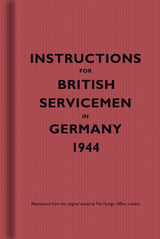 Instructions for British Servicemen in Germany, 1944
Edited by the Bodleian Library
Bodleian Library Publishing, 2007 “Don’t be too ready to listen to stories told by attractive women. They may be acting under orders.” This was only one of the many warnings given to the 30,000 British troops preparing to land in the enemy territory of Nazi Germany nine-and-a-half months after D-Day. The newest addition to the Bodleian Library’s bestselling series of wartime pamphlets, Instructions for British Servicemen in Germany, 1944 opens an intriguing window into the politics and military stratagems that brought about the end of World War II.
The pamphlet is both a succinct survey of German politics, culture, and history and a work of British propaganda. Not only does the pamphlet cover general cultural topics such as food and drink, currency, and social customs, but it also explains the effect of years of the war on Germans and their attitudes toward the British. The book admonishes, “The Germans are not good at controlling their feelings. They have a streak of hysteria. You will find that Germans may often fly into a passion if some little thing goes wrong.” The mix of humor and crude stereotypes—“If you have to give orders to German civilians, give them in a firm, military manner. The German civilian is used to it and expects it”—in the text make this pamphlet a stark reminder of the wartime fears and hopes of the British.
By turns a manual on psychological warfare, a travel guide, and a historical survey, Instructions for British Servicemen in Germany, 1944 offers incomparable insights into how the British, and by extension the Allied forces, viewed their fiercest enemy on the eve of its defeat.
Instructions for Folding: Poems
Willie Lin
Northwestern University Press, 2015 In one of the poems in Instructions for Folding, Willie Lin writes, “it seemed you were away but not beyond language.” And accordingly, the voice in these poems is sometimes fervid, sometimes wry, moved to speech by the specific desire to speak to someone. The poems often progress associatively, following a kind of lyric logic of involution, disruption, and juxtaposition. They rehearse the work of learning the heft and shape of memories. They revel in failures and take pleasure in mourning. They bristle with narrative suggestiveness, weaving an austere music against a scrim of love, loneliness, secrets, and elation. .
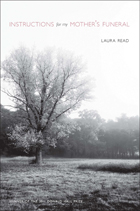 Instructions for My Mother’s Funeral
Laura Read
University of Pittsburgh Press, 2012 This collection is divided into three sections. The first opens with the speaker’s reflections on her childhood loss of her father and subsequent move to a new house and a new life, a life in which she is always alert to the absences and danger but also a life in which she begins to see language as a kind of salvation. This section also develops the speaker’s first knowledge of sex, primarily in the poems, “The Goose Girl” and “A Woman Was Raped Here.” The second section follows the speaker into adolescence and young adulthood, and these poems further explore the sexual violence in the world in which the speaker lives, and how this violence affects her own feelings toward sex and romantic love. In the third section, the book finds love, work, and family, and the poems in this section about motherhood echo back to the first section as the speaker’s own parenting is influenced by how difficult it is to love when you know people die.
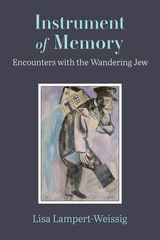 Instrument of Memory: Encounters with the Wandering Jew
Lisa Lampert-Weissig
University of Michigan Press, 2024 How can immortality be a curse? According to the Wandering Jew legend, as Jesus made his way to Calvary, a man refused him rest, cruelly taunting him to hurry to meet his fate. In response, Jesus cursed the man to wander until the Second Coming. Since the medieval period, the legend has inspired hundreds of adaptations by artists and writers. Instrument of Memory: Encounters with the Wandering Jew, the first English-language study of the legend in over fifty years, is also the first to examine the influence of the legend’s medieval and early modern sources over the centuries into the present day. Using the lens of memory studies, the work shows how the Christian tradition of the legend centered the memory of the Passion at the heart of the Wandering Jew’s curse. Instrument of Memory also shows how Jewish artists and writers have reimagined the legend through Jewish memory traditions. Through this focus on memory, Jewish adapters of the legend create complex renderings of the Wandering Jew that recognize not only the entanglement of Jewish and Christian memory, but also the impact of that entanglement on Jewish subjects. This book presents a complex, sympathetic, and more fully realized version of the legend while challenging the limits of the presentism of memory studies.
 Instrument of War: Music and the Making of America's Soldiers
David Suisman
University of Chicago Press, 2024 An original history of music in the lives of American soldiers.
Since the Civil War, music has coursed through the United States military. Soldiers have sung while marching, listened to phonographs and armed forces radio, and packed the seats at large-scale USO shows. “Reveille” has roused soldiers in the morning and “Taps” has marked the end of a long day. Whether the sounds came from brass instruments, weary and homesick singers, or a pair of heavily used earbuds, where there was war, there was music, too.
Instrument of War is a first-of-its-kind study of music in the lives of American soldiers. Although musical activity has been part of war since time immemorial, the significance of the US military as a musical institution has generally gone unnoticed. Historian David Suisman traces how the US military used—and continues to use—music to train soldiers and regulate military life, and how soldiers themselves have turned to music to cope with war’s emotional and psychological realities. Opening our ears to these practices, Suisman reveals how music has enabled more than a century and a half of American war-making. Instrument of War unsettles assumptions about music as a force of uplift and beauty, demonstrating how it has also been entangled in large-scale state violence.
Whether it involves chanting “Sound off!” in basic training, switching on a phonograph or radio, or cueing up an iPod playlist while out on patrol, the sound of music has long resonated in soldiers’ wartime experiences. Now we all can finally hear it.
Instrumental Biology, or The Disunity of Science
Alexander Rosenberg
University of Chicago Press, 1994 Do the sciences aim to uncover the structure of nature, or are they ultimately a practical means of controlling our environment?
In Instrumental Biology, or the Disunity of Science, Alexander Rosenberg argues that while physics and chemistry can develop laws that reveal the structure of natural phenomena, biology is fated to be a practical, instrumental discipline. Because of the complexity produced by natural selection, and because of the limits on human cognition, scientists are prevented from uncovering the basic structure of biological phenomena. Consequently, biology and all of the disciplines that rest upon it—psychology and the other human sciences—must aim at most to provide practical tools for coping with the natural world rather than a complete theoretical understanding of it.
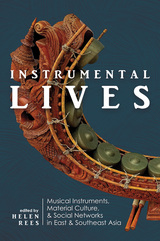 Instrumental Lives: Musical Instruments, Material Culture, and Social Networks in East and Southeast Asia
Edited by Helen Rees
University of Illinois Press, 2024 The musical instruments of East and Southeast Asia enjoy increasing recognition as parts of humanity’s intangible cultural heritage. Helen Rees edits a collection that offers vibrant new ways to link these objects to their materials of manufacture, the surrounding environment, the social networks they form and help sustain, and the wider ethnic or national imagination. Rees organizes the essays to reflect three angles of inquiry. The first section explores the characteristics and social roles of various categories of instruments, including the koto and an extinct Balinese wooden clapper. In section two, essayists focus on the life stories of individual instruments ranging from an heirloom Chinese qin to end-blown flutes in rural western Mongolia. Essays in the third section examine the ethics and other issues that surround instrument collections, but also show how collecting is a dynamic process that transforms an instrument’s habitat and social roles. Original and expert, Instrumental Lives brings a new understanding of how musical instruments interact with their environments and societies. Contributors: Supeena Insee Adler, Marie-Pierre Lissoir, Terauchi Naoko, Jennifer C. Post, Helen Rees, Xiao Mei, Tyler Yamin, and Bell Yung
 Instrumentality: On Technical Objects and Orientations in the Later Middle Ages
J. Allan Mitchell
University of Minnesota Press, 2024 From medieval to modern, exploring instrumental attitudes toward physical gadgets, diagrams, concepts, methods, and disciplines
Opening up the instrumental condition of the human for critical reflection and renewal, Instrumentality illuminates key moments in the intellectual history of the European Middle Ages. J. Allan Mitchell reveals how, in the predigital past, we can recognize many of the operative technics, analytics, and metaphorics that continue to shape human sense and cognition today. Exploring the diverse modalities of medieval instruments, Mitchell’s case studies encompass techniques as seemingly distinct as time-keeping mechanisms, mathematical diagrams, logical syllogisms, and the literary devices of Geoffrey Chaucer and John Gower. A cultural and intellectual history, Mitchell’s work leads readers from three-dimensional objects (physical mechanisms) to two-dimensional inscriptions (maps and diagrams) and onward to overarching disciplinary norms in the early liberal and mechanical arts. Prying loose the subtle, adaptable, and generative concept of technical objects from limiting contemporary frameworks, he shows how these instruments are indispensable to the past—and the future—of the arts and culture at large.
 Instruments of Desire: The Electric Guitar and the Shaping of Musical Experience
Steve Waksman
Harvard University Press, 2001 Around 1930, a group of guitar designers in Southern California fitted instruments with an electromagnetic device called a pickup--and forever changed the face of popular music. Taken up by musicians as diverse as Les Paul, Muddy Waters, Jimi Hendrix, and the MC5, the electric guitar would become not just a conduit of electrifying new sounds but also a symbol of energy, innovation, and desire in the music of the day. Instruments of Desire is the first full account of the historical and cultural significance of the electric guitar, a wide-ranging exploration of how and why the instrument has had such broad musical and cultural impact.
Instruments of Desire ranges across the history of the electric guitar by focusing on key performers who have shaped the use and meaning of the instrument: Charlie Christian, Les Paul, Chet Atkins, Muddy Waters, Chuck Berry, Jimi Hendrix, the MC5, and Led Zeppelin. The book traces two competing ideals for the sound of the instrument: one, focusing on tonal purity, has been favored by musicians seeking to integrate the electric guitar into the existing conventions of pop music; the other, centering on timbral distortion, has been used to challenge popular notions of "acceptable" and "unacceptable" noise. Instruments of Desire reveals how these different approaches to sound also entail different ideas about the place of the body in musical performance, the ways in which music articulates racialized and gendered identities, and the position of popular music in American social and political life.
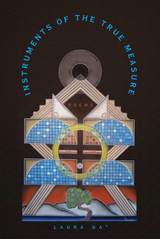 Instruments of the True Measure: Poems
Laura Da'
University of Arizona Press, 2018 Instruments of the True Measure charts the coordinates and intersections of land, history, and culture. Lyrical passages map the parallel lives of ancestral figures and connect dispossessions of the past to lived experiences of the present. Shawnee history informs the collection, and Da’s fascination with uncovering and recovering brings the reader deeper into the narrative of Shawnee homeland. Images of forced removal and frontier violence reveal the wrenching loss and reconfiguration of the Shawnee as a people. The body and history become lands that are measured and plotted with precise instruments.
Surveying and geography underpin the collection, but even as Da’ investigates these signifiers of measurement, she pushes the reader to interrogate their function within the stark atrocities of American history. Da’ laments this harsh dichotomy, observing that America’s mathematical point of beginning is located in the heart of her tribe’s homeland: “I do not have the Shawnee words to describe this place; the notation that is available to me is 40°38´32.61´´ N 80°31´9.76´´ W.”
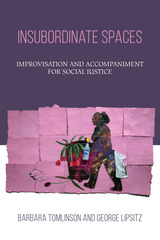 Insubordinate Spaces: Improvisation and Accompaniment for Social Justice
Barbara Tomlinson
Temple University Press, 2019 Insubordinate spaces are places of possibility, products of acts of accompaniment and improvisation that deepen capacities for democratic social change. Barbara Tomlinson and George Lipsitz’s Insubordinate Spaces explores the challenges facing people committed to social justice in an era when social institutions have increasingly been reconfigured to conform to the imperatives of a market society. In their book, the authors argue that education, the arts, and activism are key terrains of political and ideological conflict. They explore and analyze exemplary projects responding to current social justice issues and crises, from the Idle No More movement launched by Indigenous people in Canada to the performance art of Chingo Bling, Fandango convenings, the installation art of Ramiro Gomez, and the mass protests proclaiming “Black Lives Matter" in Ferguson, MO. Tomlinson and Lipsitz draw on key concepts from struggles to advance ideas about reciprocal recognition and co-creation as components in the construction of new egalitarian and democratic social relations, practices, and institutions.
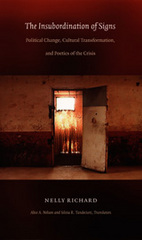 The Insubordination of Signs: Political Change, Cultural Transformation, and Poetics of the Crisis
Nelly Richard
Duke University Press, 2004 Nelly Richard is one of the most prominent cultural theorists writing in Latin America today. As a participant in Chile’s neo-avantgarde, Richard worked to expand the possibilities for cultural debate within the constraints imposed by the Pinochet dictatorship (1973–1990), and she has continued to offer incisive commentary about the country’s transition to democracy. Well known as the founder and director of the influential journal Revista de crítica cultural, based in Santiago, Richard has been central to the dissemination throughout Latin America of work by key contemporary thinkers, including Néstor García Canclini, Jacques Derrida, Fredric Jameson, and Diamela Eltit. Her own writing provides rigorous considerations of Latin American identity, postmodernism, gender, neoliberalism, and strategies of political and cultural resistance. In The Insubordination of Signs Richard theorizes the cultural reactions—particularly within the realms of visual arts, literature, and the social sciences—to the oppression of the Chilean dictatorship. She reflects on the role of memory in the historical shadow of the military regime and on the strategies offered by marginal discourses for critiquing institutional systems of power. She considers the importance of Walter Benjamin for the theoretical self-understanding of the Latin American intellectual left, and she offers revisionary interpretations of the Chilean neo-avantgarde in terms of its relationships with the traditional left and postmodernism. Exploring the gap between Chile’s new left social sciences and its “new scene” aesthetic and critical practices, Richard discusses how, with the return of democracy, the energies that had set in motion the democratizing process seemed to exhaust themselves as cultural debate was attenuated in order to reduce any risk of a return to authoritarianism.
 Insufferable Tools: Feminism Against Big Tech
Sarah Sharma
Duke University Press, 2026 In a world seemingly run by the whims and power plays of Musks and Zucks, Insufferable Tools cuts to the core of modern technology’s gendered politics. Sarah Sharma challenges the idea that the Big Tech broligarchs are neutral utilitarians who view technology as mere tools. She shows instead how these tech giants have turned the internet, and, increasingly, “real life” into a set of environments which they cultivate and manipulate to wield the real tools: us, the users. Sharma critiques a popular system of inclusion she calls “Big Tech Feminism” that attempts to incorporate and make useful people of color, queer people, and others who are seen as broken machines in the current gendered power structures. Deconstructing Big Tech’s patriarchal deployment of media theory to gain and maintain power, Sharma proposes a feminist techno-politics that can forge new futures free from the grip of the truly insufferable tools.
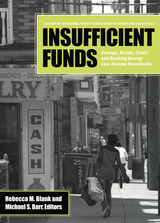 Insufficient Funds: Savings, Assets, Credit, and Banking Among Low-Income Households
Rebecca M. Blank
Russell Sage Foundation, 2009 One in four American adults doesn’t have a bank account. Low-income families lack access to many of the basic financial services middle-class families take for granted and are particularly susceptible to financial emergencies, unemployment, loss of a home, and uninsured medical problems. Insufficient Funds explores how institutional constraints and individual decisions combine to produce this striking disparity and recommends policies to help alleviate the problem. Mainstream financial services are both less available and more expensive for low-income households. High fees, minimum-balance policies, and the relative scarcity of banks in poor neighborhoods are key factors. Michael Barr reports the results of an in-depth study of financial behavior in 1,000 low- and moderate-income families in metropolitan Detroit. He finds that most poor households have bank accounts, but combine use of mainstream services with alternative options such as money orders, pawnshops, and payday lenders. Barr suggests that a tax credit for banks serving primarily disadvantaged customers could facilitate greater equality in the private financial sector. Drawing on evidence from behavioral economics, Sendhil Mullainathan and Eldar Shafir show that low-income individuals exhibit many of the same patterns and weaknesses in financial decision making as middle-class individuals and could benefit from many of the same financial aids. They argue that savings programs that automatically enroll participants and require them to actively opt out in order to leave the program could drastically increase savings ability. Ronald Mann demonstrates that significant changes in the credit market over the past fifteen years have allowed companies to expand credit to a larger share of low-income families. Mann calls for regulations on credit card companies that would require greater disclosure of actual interest rates and fees. Raphael Bostic and Kwan Lee find that while home ownership has risen dramatically over the past twenty years, elevated risks for low-income families—such as foreclosure—may well outweigh the benefits of owning a home. The authors ultimately argue that if we want to demand financial responsibility from low-income households, we have an obligation to assure that these families have access to the banking, credit, and savings institutions that are readily available to higher-income families. Insufficient Funds highlights where and how access is blocked and shows how government policy and individual decisions could combine to eliminate many of these barriers in the future.
The Insular Worlds of Byzantium, ca. 550–ca. 900
Luca Zavagno
Arc Humanities Press, 2025 This book explores the "Byzantine" islands of the late antique Mediterranean through different methodologies and a wide array of sources in comparative perspective. It deals with transversal themes centered on the peculiar political and economic structures of insular societies (such as the episcopate and the archontate or, in the case of Sicily, the theme). Reassessing the exaggerated space that the historiography on Byzantine islands has traditionally granted to literary and documentary sources, this book draws upon archaeological evidence that points instead to a less violent and disruptive phase in the islands' history as Late Antiquity passed into the early Middle Ages. The islands are also considered as hubs of connectivity where the Islamic and the Byzantine cultures encountered and heavily influenced the local "insular" political, economic, and social structures across the centuries.
Insulators for High Voltages
J.S.T. Looms
The Institution of Engineering and Technology, 1988 This book is a guide to the whole field of high voltage insulators as used in electrical power networks, traction and production. It covers the historical development of the shapes - sometimes strange ones - of modern types, decribes the principal materials - both ceramic and polymeric - and their fabrication, explains the physical principles of contamination and flashover, and reviews the mass of data on research and testing.
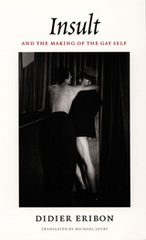 Insult and the Making of the Gay Self
Didier Eribon
Duke University Press, 2004 A bestseller in France following its publication in 1999, Insult and the Making of the Gay Self is an extraordinary set of reflections on “the gay question” by Didier Eribon, one of France’s foremost public intellectuals. Known internationally as the author of a pathbreaking biography of Michel Foucault, Eribon is a leading voice in French gay studies. In explorations of gay subjectivity as it is lived now and as it has been expressed in literary history and in the life and work of Foucault, Eribon argues that gay male politics, social life, and culture are transformative responses to an oppressive social order. Bringing together the work of Jean-Paul Sartre, Pierre Bourdieu, Judith Butler, and Erving Goffman, he contends that gay culture and political movements flow from the need to overcome a world of insult in the process of creating gay selves. Eribon describes the emergence of homosexual literature in Britain and France at the turn of the last century and traces this new gay discourse from Oscar Wilde and the literary circles of late-Victorian Oxford to André Gide and Marcel Proust. He asserts that Foucault should be placed in a long line of authors—including Wilde, Gide, and Proust—who from the nineteenth century onward have tried to create spaces in which to resist subjection and reformulate oneself. Drawing on his unrivaled knowledge of Foucault’s oeuvre, Eribon presents a masterful new interpretation of Foucault. He calls attention to a particular passage from Madness and Civilization that has never been translated into English. Written some fifteen years before The History of Sexuality, this passage seems to contradict Foucault’s famous idea that homosexuality was a late-nineteenth-century construction. Including an argument for the use of Hannah Arendt’s thought in gay rights advocacy, Insult and the Making of the Gay Self is an impassioned call for critical, active engagement with the question of how gay life is shaped both from without and within.
Insult to Injury: Libel, Slander, and Invasions of Privacy
Christa Jones
University Press of Colorado, 2003 William K. Jones reviews the seminal US Supreme Court decisions that restrict the First Amendment in order to protect persons against defamatory falsehoods, invasions of privacy, and related psychic harm. Covering cases ranging from a restaurant owner dri
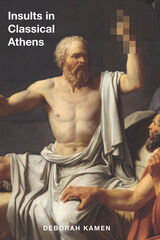 Insults in Classical Athens
Deborah Kamen
University of Wisconsin Press, 2022 Scholarly investigations of the rich field of verbal and extraverbal Athenian insults have typically been undertaken piecemeal. Deborah Kamen provides an overview of this vast terrain and synthesizes the rules, content, functions, and consequences of insulting fellow Athenians. The result is the first volume to map out the full spectrum of insults, from obscene banter at festivals, to invective in the courtroom, to slander and even hubristic assaults on another's honor.
While the classical city celebrated the democratic equality of "autochthonous" citizens, it counted a large population of noncitizens as inhabitants, so that ancient Athenians developed a preoccupation with negotiating, affirming, and restricting citizenship. Kamen raises key questions about what it meant to be a citizen in democratic Athens and demonstrates how insults were deployed to police the boundaries of acceptable behavior. In doing so, she illuminates surprising differences between antiquity and today and sheds light on the ways a democratic society valuing "free speech" can nonetheless curb language considered damaging to the community as a whole.
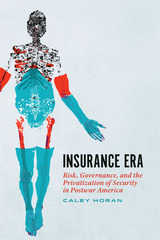 Insurance Era: Risk, Governance, and the Privatization of Security in Postwar America
Caley Horan
University of Chicago Press, 2021 Charts the social and cultural life of private insurance in postwar America, showing how insurance institutions and actuarial practices played crucial roles in bringing social, political, and economic neoliberalism into everyday life.
Actuarial thinking is everywhere in contemporary America, an often unnoticed byproduct of the postwar insurance industry’s political and economic influence. Calculations of risk permeate our institutions, influencing how we understand and manage crime, education, medicine, finance, and other social issues. Caley Horan’s remarkable book charts the social and economic power of private insurers since 1945, arguing that these institutions’ actuarial practices played a crucial and unexplored role in insinuating the social, political, and economic frameworks of neoliberalism into everyday life.
Analyzing insurance marketing, consumption, investment, and regulation, Horan asserts that postwar America’s obsession with safety and security fueled the exponential expansion of the insurance industry and the growing importance of risk management in other fields. Horan shows that the rise and dissemination of neoliberal values did not happen on its own: they were the result of a project to unsocialize risk, shrinking the state’s commitment to providing support, and heaping burdens upon the people often least capable of bearing them. Insurance Era is a sharply researched and fiercely written account of how and why private insurance and its actuarial market logic came to be so deeply lodged in American visions of social welfare.
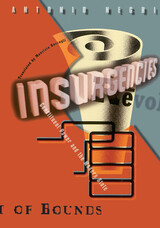 Insurgencies: Constituent Power And The Modern State
Antonio Negri
University of Minnesota Press, 1999 A modern revolutionary's fresh approach to radical thought.
At a time when political paradigms are collapsing, and the death of Marxism and the Left is proclaimed, Insurgencies offers an intellectually invigorating and historically wide-ranging appraisal of the real legacy and promise of revolutionary thought and practice.
At the center of this book is the conflict between "constituent power," the democratic force of revolutionary innovation, and "constituted power," the fixed power of formal constitutions and central authority. This conflict, Antonio Negri argues, defines the drama of modern rebellions, from Machiavelli's Florence and Harrington's England to the American, French, and Russian revolutions. Insurgencies leads to a new notion of how power and action must be understood if we are to achieve a radically democratic future.
After living in exile in France for nearly fourteen years, Antonio Negri is currently serving a jail sentence in Italy, his home country, for his political activism in the 1970s. His conviction, which was based on the substance of his writings, led Michel Foucault to ask, "Isn't he in prison simply for being an intellectual?" Negri's works in English include The Savage Anomaly (1991) and, with Michael Hardt, Labor of Dionysus (1994).
Maurizia Boscagli is associate professor of English at the University of California, Santa Barbara.
Insurgencies: Constituent Power and the Modern State
Antonio Negri
University of Minnesota Press, 2009 New Edition In the ten years since the initial publication of Insurgencies, Antonio Negri's reputation as one of the world's foremost political philosophers has grown dramatically. An invigorating appraisal of revolutionary thought, Insurgencies is both the precursor to and the historical basis for Antonio Negri and Michael Hardt's masterwork, Empire. At the center of this book is the conflict between "constituent power," the democratic force of revolutionary innovation, and "constituted power," the fixed power of formal constitutions and central authority. This conflict, Negri argues, defines the drama of modern rebellions. Now with a foreword by Michael Hardt, Insurgencies leads to a new notion of how power and action must be understood if we are to achieve a democratic future.
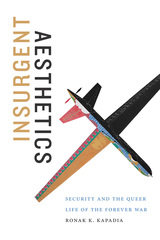 Insurgent Aesthetics: Security and the Queer Life of the Forever War
Ronak K. Kapadia
Duke University Press, 2019 In Insurgent Aesthetics Ronak K. Kapadia theorizes the world-making power of contemporary art responses to US militarism in the Greater Middle East. He traces how new forms of remote killing, torture, confinement, and surveillance have created a distinctive post-9/11 infrastructure of racialized state violence. Linking these new forms of violence to the history of American imperialism and conquest, Kapadia shows how Arab, Muslim, and South Asian diasporic multimedia artists force a reckoning with the US war on terror's violent destruction and its impacts on immigrant and refugee communities. Drawing on an eclectic range of visual, installation, and performance works, Kapadia reveals queer feminist decolonial critiques of the US security state that visualize subjugated histories of US militarism and make palpable what he terms “the sensorial life of empire.” In this way, these artists forge new aesthetic and social alliances that sustain critical opposition to the global war machine and create alternative ways of knowing and feeling beyond the forever war.
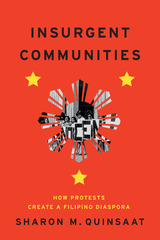 Insurgent Communities: How Protests Create a Filipino Diaspora
Sharon M. Quinsaat
University of Chicago Press, 2024 Sociologist Sharon M. Quinsaat sheds new light on the formation of diasporic connections through transnational protests.
When people migrate and settle in other countries, do they automatically form a diaspora? In Insurgent Communities, Sharon M. Quinsaat explains the dynamic process through which a diaspora is strategically constructed. Quinsaat looks to Filipinos in the United States and the Netherlands—examining their resistance against the dictatorship of Ferdinand Marcos, their mobilization for migrants’ rights, and the construction of a collective memory of the Marcos regime—to argue that diasporas emerge through political activism. Social movements provide an essential space for addressing migrants’ diverse experiences and relationships with their homeland and its history. A significant contribution to the interdisciplinary field of migration and social movements studies, Insurgent Communities illuminates how people develop collective identities in times of social upheaval.
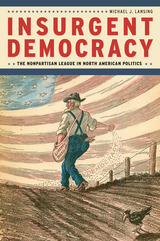 Insurgent Democracy: The Nonpartisan League in North American Politics
Michael J. Lansing
University of Chicago Press, 2015 In 1915, western farmers mounted one of the most significant challenges to party politics America has seen: the Nonpartisan League, which sought to empower citizens and restrain corporate influence. Before its collapse in the 1920s, the League counted over 250,000 paying members, spread to thirteen states and two Canadian provinces, controlled North Dakota’s state government, and birthed new farmer-labor alliances. Yet today it is all but forgotten, neglected even by scholars.
Michael J. Lansing aims to change that. Insurgent Democracy offers a new look at the Nonpartisan League and a new way to understand its rise and fall in the United States and Canada. Lansing argues that, rather than a spasm of populist rage that inevitably burned itself out, the story of the League is in fact an instructive example of how popular movements can create lasting change. Depicting the League as a transnational response to economic inequity, Lansing not only resurrects its story of citizen activism, but also allows us to see its potential to inform contemporary movements.
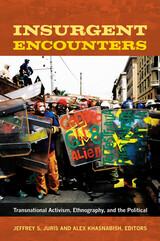 Insurgent Encounters: Transnational Activism, Ethnography, and the Political
Jeffrey S. Juris and Alex Khasnabish, eds.
Duke University Press, 2013 Insurgent Encounters illuminates the dynamics of contemporary transnational social movements, including those advocating for women and indigenous groups, environmental justice, and alternative—cooperative rather than exploitative—forms of globalization. The contributors are politically engaged scholars working within the social movements they analyze. Their essays are both models of and arguments for activist ethnography. They demonstrate that such a methodology has the potential to reveal empirical issues and generate theoretical insights beyond the reach of traditional social-movement research methods. Activist ethnographers not only produce new understandings of contemporary forms of collective action, but also seek to contribute to struggles for social change. The editors suggest networks and spaces of encounter as the most useful conceptual rubrics for understanding shape-shifting social movements using digital and online technologies to produce innovative forms of political organization across local, regional, national, and transnational scales. A major rethinking of the practice and purpose of ethnography, Insurgent Encounters challenges dominant understandings of social transformation, political possibility, knowledge production, and the relation between intellectual labor and sociopolitical activism.
Contributors. Giuseppe Caruso, Maribel Casas-Cortés, Janet Conway, Stéphane Couture, Vinci Daro, Manisha Desai, Sylvia Escárcega, David Hess, Jeffrey S. Juris, Alex Khasnabish, Lorenzo Mosca, Michal Osterweil, Geoffrey Pleyers, Dana E. Powell, Paul Routledge, M. K. Sterpka, Tish Stringer
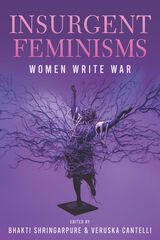 Insurgent Feminisms: Women Write War
Bhakti Shringarpure
UpSet Press, 2023 Insurgent Feminisms: Women Write War brings together ten years of writing published on Warscapes magazine through the lens of gender. Since its founding in November 2011, Warscapes has urged an immersive reflection on war not as nationalist exercise but as an affective, traumatic and inevitable burden upon the victim, the witness, the artist and the ethicist.
In this collection, insurgency emerges in the raw and meticulous language of witnessing, and in the desire to render the space of conflict in radically different ways. There are no paeans to courageous soldiers here, nor pat nationalist rhetoric, nor bravado about saving lives. These perspectives on war come out of regions and positions that defy stereotypical war reportage or the expected war story. They disobey the rules of war writing and do not subordinate themselves to the usual themes and tropes that we have become so used to reading. Instead, Insurgent Feminisms advances a new paradigm of war writing. Truth rises to the top when these writers choose to dissent from the received wisdoms, styles and socio-political structures of violence that constantly put gendered bodies at risk.
Insurgent Feminisms comprises reportage, fiction, memoir, poetry and conversations from over sixty writers from thirty regions, primarily from the Global South, and includes contributions by Suchitra Vijayan, Chika Unigwe, Belen Fernandez, Otoniya Juliane Okot Bitek, Nathalie, Handal Gaiutra Bahadur, Robtel Neajai Pailey, Sumana Roy and Lina Mounzer, as well as conversations with Ubah Cristina Ali Farah, Sarah Ladipo Manyika, Lara Pawson, Panashe Chigumadzi and Annemarie Jacir, among several others.
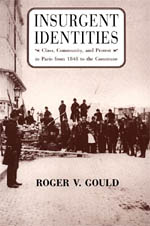 Insurgent Identities: Class, Community, and Protest in Paris from 1848 to the Commune
Roger V. Gould
University of Chicago Press, 1995 In this important contribution both to the study of social protest and to French social history, Roger Gould breaks with previous accounts that portray the Paris Commune of 1871 as a continuation of the class struggles of the 1848 Revolution. Focusing on the collective identities framing conflict during these two upheavals and in the intervening period, Gould reveals that while class played a pivotal role in 1848, it was neighborhood solidarity that was the decisive organizing force in 1871.
The difference was due to Baron Haussmann's massive urban renovation projects between 1852 and 1868, which dispersed workers from Paris's center to newly annexed districts on the outskirts of the city. In these areas, residence rather than occupation structured social relations. Drawing on evidence from trail documents, marriage records, reports of police spies, and the popular press, Gould demonstrates that this fundamental rearrangement in the patterns of social life made possible a neighborhood insurgent movement; whereas the insurgents of 1848 fought and died in defense of their status as workers, those in 1871 did so as members of a besieged urban community.
A valuable resource for historians and scholars of social movements, this work shows that collective identities vary with political circumstances but are nevertheless constrained by social networks. Gould extends this argument to make sense of other protest movements and to offer predictions about the dimensions of future social conflict.
 Insurgent Visions: Feminism, Justice, Solidarity
Chandra Talpade Mohanty
Duke University Press, 2025 In a current era marked by carceral logics, authoritarianism, and white supremacy, there has never been a greater need for the tools and inspiration that radical feminism provides. In Insurgent Visions, Chandra Talpade Mohanty explores methods of anticapitalist resistance to radically transform everyday life. She presents insurgent feminism—a theory and praxis with which to contest and replace the practices of violence grounded in racialized gender relations. Insurgent feminism unsettles existing power structures in order to enact new relationships and forge new subjectivities, epistemologies, and communities. Drawing on organizing efforts in the US-Mexico borderlands, Palestine/Israel, and Kashmir, as well as on abolitionist and Dalit feminisms, Mohanty contends that the knowledge that emerges from the experiences of marginalized groups who are struggling for economic, racial, and social justice is key for imagining feminist futures. She also turns to the neoliberal landscape of higher education in the United States and the difficulties of instituting transformative antiracist and anti-imperialist feminist knowledge building. Mapping new challenges for radical praxis, Mohanty reconfigures feminist studies while offering a model for decolonial cross-border organizing and solidarity.
 Insurgent Women: Female Combatants in Civil Wars
Jessica Trisko Darden, Alexis Henshaw, and Ora Szekely
Georgetown University Press, 2019 Why do women go to war? Despite the reality that female combatants exist the world over, we still know relatively little about who these women are, what motivates them to take up arms, how they are utilized by armed groups, and what happens to them when war ends. This book uses three case studies to explore variation in women’s participation in nonstate armed groups in a range of contemporary political and social contexts: the civil war in Ukraine, the conflicts involving Kurdish groups in the Middle East, and the civil war in Colombia. In particular, the authors examine three important aspects of women’s participation in armed groups: mobilization, participation in combat, and conflict cessation. In doing so, they shed light on women’s pathways into and out of nonstate armed groups. They also address the implications of women’s participation in these conflicts for policy, including postconflict programming. This is an accessible and timely work that will be a useful introduction to another side of contemporary conflict.
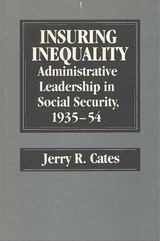 Insuring Inequality: Administrative Leadership in Social Security, 1935-54
Jerry R. Cates
University of Michigan Press, 1983 The establishment of the Social Security Board in 1935 confronted administrators and policy makers with basic value decisions. Should the system serve to raise the incomes of America's neediest citizens? Or did that aim smack too much of the ideology of redistribution of wealth? Would it rob workers of incentives to provide for their own futures and reward idleness? The conflict of values was played out on a political stage marked by infighting, deception, and short-sighted compromise. The result is the social security system we know today— one that benefits those who need it least, and one that is in a perpetual state of financial difficulty. Insuring Inequality is a penetrating analysis and indictment of that bureaucracy which felt the welfare of America's aged was an acceptable price to pay for the preservation of an ideologically correct social insurance system— a system that would not seriously challenge income inequality in America. Previously unresearched documents not only reveal that social insurance discriminates against the poor and this was a foreseen, intended consequence; but they also reveal that the leaders predicted a financially troubled system and did little to prevent it.
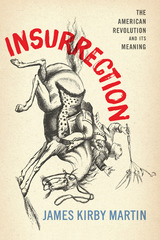 Insurrection: The American Revolution and Its Meaning
James Kirby Martin
Westholme Publishing, 2019 A New Edition of an Important Interpretation of One of the Greatest Events in World History
The Revolutionary generation believed they were living in dangerous, turbulent times. Their uprising against British imperial authority beginning in the 1760s represented an attempt to preserve their liberties in the face of what they perceived as a conspiracy from above, ultimately brought on by a tyrannical king and Parliament. The actual number of insurgents—we call them rebels or patriots—represented no more than 20 to 25 percent of the populace. Approximately the same number of persons refused to renounce their loyalty to the British Crown; and thousands of them joined British arms to crush the patriot insurrection. Not committed to supporting either side were large numbers of neutrals whose allegiance varied with their proximity to competing military forces. Once independence was secured, however, a great shift occurred. Some key Revolutionary leaders began to worry that the common people, if given too much political authority, would produce agitation from below that could destroy the delicate fabric of the newly established republic. Reckoning with this social and political disorder resulted in a series of constitutional settlements. What emerged was a more democratic system of government operating, at least theoretically, in the name of a sovereign people who had replaced the king and Parliament.
In Insurrection: The American Revolution and Its Meaning, award-winning historian James Kirby Martin discusses the causes, course, and consequences of the War for Independence. While interpretations of the Revolution and its short- and long-term meaning abound, Martin emphasizes that the insurrection against British monarchism led to more profound changes in human institutions and ideals than many of the Revolutionary leaders actually envisioned or wanted. Once unleashed, the genie of greater freedom and liberty for all could not be forced back into the bottle, no matter how much some persons would have desired.
 Intangible Materialism: The Body, Scientific Knowledge, and the Power of Language
Ronald Schleifer
University of Minnesota Press, 2009 Taking as his point of departure Norbert Weiner’s statement that information is basic to understanding materialism in our era, Ronald Schleifer shows how discoveries of modern physics have altered conceptions of matter and energy and the ways in which both information theory and the study of literature can enrich these conceptions. Expanding the reductive notion of “the material” as simply matter and energy, he formulates a new, more inclusive idea of materialism. Schleifer’s project attempts to bridge the divisions between the humanities and the sciences and to create a nonreductive materialism for the information age. He presents a materialistic account of human bodily experience by delving into language and literature that powerfully represents our faces, voices, hands, and pain. For example, he examines the material resources of poetic “literariness” as it is revealed in the condition of Tourette’s syndrome. Schleifer also investigates gestures of the hand in the formation of sociality, and he studies pain as both a physiological and phenomenological experience. This ambitious work explores physiological analyses, evolutionary explanations, and semiotic descriptions of materialism to reveal how aspects of physical existence discover meaning in experience.
Integral Equation Methods for Electromagnetics
John L. Volakis
The Institution of Engineering and Technology, 2012 This text/reference is a detailed look at the development and use of integral equation methods for electromagnetic analysis, specifically for antennas and radar scattering. Developers and practitioners will appreciate the broad-based approach to understanding and utilizing integral equation methods and the unique coverage of historical developments that led to the current state-of-the-art. In contrast to existing books, Integral Equation Methods for Electromagnetics lays the groundwork in the initial chapters so students and basic users can solve simple problems and work their way up to the most advanced and current solutions.
Integral Equations for Real-Life Multiscale Electromagnetic Problems
Francesca Vipiana
The Institution of Engineering and Technology, 2024 Integral Equations for Real-Life Multiscale Electromagnetic Problems brings together and explains the main available approaches for the numerical solution of surface integral equations that can be used to analyse real-world multi-scale electromagnetic problems. In computational electromagnetics, formulations based on surface integral equations are currently the most commonly-used option for the analysis of electrically large and complex structures, but it is essential to have available state-of-the-art techniques to solve them in an efficient and accurate way.
Integrated Coastal and Ocean Management: Concepts And Practices
Biliana Cicin-Sain and Robert W. Knecht; Foreword by Gunnar Kullenberg
Island Press, 1998 Biliana Cicin-Sain and Robert W. Knecht are co-directors of the Center for the Study of Marine Policy at the University of Delaware in Newark, Delaware and co-authors of The Future of U.S. Ocean Policy (Island Press, 1998).
Integrated Fault Diagnosis and Control Design of Linear Complex Systems
Mohammadreza Davoodi
The Institution of Engineering and Technology, 2018 As control systems become more complex and are expected to perform tasks in unknown and extreme environments, they may be subject to various types of faults in their sensors, actuators or other components. It is crucial to be able to diagnose the occurrence of faults and to repair them in order to maintain, guarantee, and improve the overall safety, reliability, and performance of the systems. This book addresses the design challenges of developing and implementing novel integrated fault diagnosis and control technologies for complex linear systems.
Integrated Intelligence: Combining Human and Artificial Intelligence for Competitive Advantage
Ulrich Lichtenthaler
Campus Verlag, 2020 Artificial intelligence (AI) is omnipresent in our daily lives, from our ever-present cell phones to transportation and banking. But are businesses using these tools to their full potential? So far, most firms use AI tools primarily for enhancing efficiency and automating jobs. However, as Ulrich Lichtenthaler shows, by making AI a core part of their innovation strategy, business can achieve an unbeatable competitive advantage.
This book will show executives, HR professionals, and consultants how to gradually develop the tools of AI for building a unique intelligence architecture. Including detailed guidelines for implementation and many examples from the world’s most innovative companies, Integrated Intelligence reveals how executives can achieve a sustainable competitive advantage through intelligence-based business models.
Integrated Landscaping: Following Nature’s Lead
Lauren Chase-Rowell
University of New Hampshire Press, 2012 Most landscape manuals describe a linear sequence of processes: design, plant selection, installation, and ongoing maintenance. Integrated Landscaping is different. It uses natural ecosystems as models, taking a nonlinear, holistic approach that addresses these processes simultaneously. Integrated Landscaping treats each site as a system of plant and animal communities, considering their interrelationships with each other and their environment.
Integrated Landscaping: Following Nature's Lead is a valuable resource for anyone concerned with helping to shape the landscape we all share. When we see ourselves as part of the whole, we can see that what we do in places where we live, work, and play has a ripple effect far beyond the space each of us calls home.
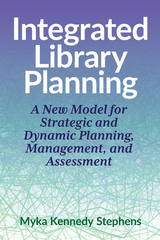 Integrated Library Planning: A New Model for Strategic and Dynamic Planning, Management, and Assessment
Myka Kennedy Stephens
Association of College & Research Libraries, 2023 Many library project plans, from small projects to institution-wide strategic planning committees, follow a linear trajectory: create the plan, do the plan, then review the outcome. While this can be effective, it also sometimes leads to disregarding new information that emerges while executing the plan, making the outcome less effective. Planning processes can also feel forced and predetermined if stakeholder feedback is not seriously considered. When this happens too many times, people stop offering their honest opinions and new ideas because they have learned that the planners do not really want to hear them.
In a concise seven chapters offering illustrations, charts, sample outlines, and many tools and resources, Integrated Library Planning offers a different kind of approach to planning that is both strategic and dynamic. It is fueled by open communication, honest assessment, and astute observation. Voices at the table, near the table, and far from the table are heard and considered. Its perpetual rhythm gives space to consider new information when it emerges and freedom to make changes at a time that makes sense instead of when it is most convenient or expected.
The era of fixed-length strategic plans is coming to an end. Five-year strategic plans had already given way to three-year strategic plans, and now we find ourselves needing to plan and function when nothing is certain beyond the present moment. The components of this model might look deceptively similar to the strategic planning practices used in libraries and organizations for decades; however, when implemented as a whole, with a monthly review cycle on a rolling planning horizon and space for regular analysis of information needs and behavior, it has the potential to shatter any previous notions of planning that serve only to satisfy administrators. Integrated Library Planning can help libraries effectively navigate and become agents of change.
 The Integrated Life: Essays, Sketches and Poems
Thomas P. Beyer
University of Minnesota Press, 1948
The Integrated Life was first published in 1948. Minnesota Archive Editions uses digital technology to make long-unavailable books once again accessible, and are published unaltered from the original University of Minnesota Press editions.
This volume of essays and poems is representative of the work and life of their author, a professor of English at Hamline University and for any years chairman of the department.
Of the essays, some are personal, others works of literary appreciation, and still others discuss the profession of teaching, in particular the teaching of English; all reveal the man who wrote them.
At Hamlin Dr. Beyer and reading have been almost synonymous. He proposed the general reading course in 1921 and directed it for twelve years. Students alert to this form of inspiration found existing delight not only in the outside reading but in the discussions with faculty members which followed. Colleagues and off-campus friends also came under provocative influence of Dr. Beyer, and his guidance has been frequently and freely acknowledged.
When Dr. Beyer was honored in 1947 for his long fruitful association with Hamline University, a publication fund was established. It was unanimously agreed that a collection of Dr. Beyer's own essays, poems, and sketches should be the first venture. The Integrated Life is that volume. No attempt has been made to bring the material up to date. The collection appears as it was written—full of the flavor and wisdom of a truly honorable teacher and friend.
Integrated Motor Drives
Xu Deng
The Institution of Engineering and Technology, 2022 To optimise the efficiency of electric drives it is necessary to consider the components; the power electronic converter, the electric machine and the gearbox, together. Integrated systems can be smaller and have better flexibility and thermal management. Integrated motor drives (IMDs) specifically offer advantages including lower cost of installation and higher power density. This integration concept has been adopted in various electrical machine drive systems as well as electric vehicles.
Integrated Optics: Characterization, devices, and applications, Volume 2
Giancarlo C. Righini
The Institution of Engineering and Technology, 2021 Edited by two recognised experts, this book in two volumes provides a comprehensive overview of integrated optics, from modelling to fabrication, materials to integration platforms, and characterization techniques to applications. The technology is explored in detail, and set in a broad context that addresses a range of current and potential future research and development trends.
Integrated Optics: From fundamentals to recent advances
Giancarlo Righini
The Institution of Engineering and Technology, 2020 Edited by two recognised experts, this book provides a comprehensive overview of integrated optics, from modelling to fabrication, materials to integration platforms, and characterization techniques to applications. The technology is explored in detail, and set in a broad context that addresses a range of current and potential future research and development trends.
Integrated Optics: Modeling, material platforms and fabrication techniques, Volume 1
Giancarlo C. Righini
The Institution of Engineering and Technology, 2021 Edited by two recognised experts, this book in two volumes provides a comprehensive overview of integrated optics, from modelling to fabrication, materials to integration platforms, and characterization techniques to applications. The technology is explored in detail, and set in a broad context that addresses a range of current and potential future research and development trends.
 Integrating Career Preparation into Language Courses
Darcy Lear
Georgetown University Press, 2019 Integrating Career Preparation into Language Courses provides foreign and second language teachers with easy and practical additions they can make to their existing curricula to help their students develop real-world professional skills and prepare to use the target language successfully in the workplace. The book is organized into six chapters, each addressing a different professional skill and opening with an explanation of how content typically included in a foreign language curriculum can be tied to this skill. Each chapter closes with class activities or lesson plans that include suggested materials and assessments that teachers can easily add to their language courses. Lear’s book is an accessible and practical guide designed to be adaptable for any language, offering exciting new possibilities to help teachers and students of foreign languages bring their language skills into the workplace.
 Integrating Family Planning Training into Medical Education: A Case Study of St. Paul's Hospital Millennium Medical College
Lia T. Gebremedhin
Michigan Publishing, 2017 This case study chronicles the integration of pre-service training in contraception and comprehensive abortion care into the medical school and OBGYN residency training program at St. Paul’s Hospital Millennium Medical College (SPHMMC) through an authentic partnership with the University of Michigan. The case study showcases the key elements that were crucial in the successful implementation of the SPHMMC program, which has now become mainstream and has been emulated in eight other medical schools in Ethiopia through the University of Michigan’s Center for International Reproductive Health Training (CIRHT).
The innovative approach, founded on the values of sustainable capacity building through academic partnership and centered on improving access to dignified women’s reproductive health care through effective pre-service training, has the potential for expansion to other countries with high rates of maternal mortality and morbidity. In this case study, we spell out the best practices, which we hope will inspire academic medical centers in the Global South, global health departments/centers internationally, and the reproductive health community at large.
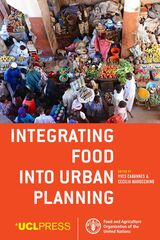 Integrating Food into Urban Planning
Edited by Yves Cabannes and Cecilia Marocchino
University College London, 2018 The integration of food into urban planning is a crucial and emerging topic. Urban planners, alongside the local and regional authorities that have traditionally been less engaged in food-related issues, are now asked to take a central and active part in understanding the way food is produced, processed, packaged, transported, marketed, consumed, disposed of, and recycled in our cities.
Despite a growing body of literature on food and cities, the issue of planning cities in such a way that they will increase food security and nutrition not only for the affluent segments of society but also the poor, is much less discussed and much informed by practice. This volume fills this gap by putting more than twenty cities’ experiences in perspective: Toronto, New York, Providence, and Portland; Cape Town and Ghana in Africa; Milan in Europe; Lima and Belo Horizonte in South America; and, in Asia, Tokyo and Bangkok, Solo, and Yogyakarta in Indonesia.
Integrating Social Media into Information Systems: Requirements, Gaps, and Potential Solutions
Douglas Yeung, Douglas
RAND Corporation, 2018 This report examines the technical challenges associated with incorporating bulk, automated analysis of social media information into procedures for vetting people seeking entry into the United States. The authors identify functional requirements and a framework for operational metrics for the proposed social media screening capabilities and provide recommendations on how to implement those capabilities.
 Integrating the Americas: FTAA and Beyond
Antoni Estevadeordal
Harvard University Press, 2004 Where Latin American government leaders once looked at free trade agreements as solely about trade and trading policies, they are increasingly viewing them as the next beacon of hope in the long and arduous road of economic reform.
Integrating the Americas: FTAA and Beyond discusses how these governments have become embroiled in a larger set of issues affecting both institutions. This work, based on a conference sponsored by the Inter-American Development Bank and the David Rockefeller Center for Latin American Studies, examines how this free trade process is surging ahead, while at the same time taking on a broader set of issues including institutional reform, transparency, the environment, labor, and social cohesion. The payoffs to the strategy of liberalization, privatization, and openness have been meager and disappointing to date. Will the FTAA be able to reverse this and allow Latin America to reap the benefits of globalization?
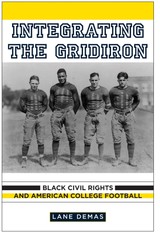 Integrating the Gridiron: Black Civil Rights and American College Football
Demas, Lane
Rutgers University Press, 2011 Even the most casual sports fans celebrate the achievements of professional athletes, among them Jackie Robinson, Muhammad Ali, and Joe Louis. Yet before and after these heroes staked a claim for African Americans in professional sports, dozens of college athletes asserted their own civil rights on the amateur playing field, and continue to do so today.
Integrating the Gridiron, the first book devoted to exploring the racial politics of college athletics, examines the history of African Americans on predominantly white college football teams from the nineteenth century through today. Lane Demas compares the acceptance and treatment of black student athletes by presenting compelling stories of those who integrated teams nationwide, and illuminates race relations in a number of regions, including the South, Midwest, West Coast, and Northeast. Focused case studies examine the University of California, Los Angeles in the late 1930s; integrated football in the Midwest and the 1951 Johnny Bright incident; the southern response to black players and the 1955 integration of the Sugar Bowl; and black protest in college football and the 1969 University of Wyoming "Black 14." Each of these issues drew national media attention and transcended the world of sports, revealing how fans—and non-fans—used college football to shape their understanding of the larger civil rights movement.
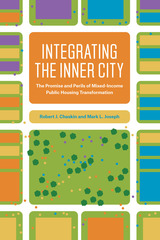 Integrating the Inner City: The Promise and Perils of Mixed-Income Public Housing Transformation
Robert J. Chaskin and Mark L. Joseph
University of Chicago Press, 2015 For many years Chicago’s looming large-scale housing projects defined the city, and their demolition and redevelopment—via the Chicago Housing Authority’s Plan for Transformation—has been perhaps the most startling change in the city’s urban landscape in the last twenty years. The Plan, which reflects a broader policy effort to remake public housing in cities across the country, seeks to deconcentrate poverty by transforming high-poverty public housing complexes into mixed-income developments and thereby integrating once-isolated public housing residents into the social and economic fabric of the city. But is the Plan an ambitious example of urban regeneration or a not-so-veiled effort at gentrification?
In the most thorough examination of mixed-income public housing redevelopment to date, Robert J. Chaskin and Mark L. Joseph draw on five years of field research, in-depth interviews, and volumes of data to demonstrate that while considerable progress has been made in transforming the complexes physically, the integrationist goals of the policy have not been met. They provide a highly textured investigation into what it takes to design, finance, build, and populate a mixed-income development, and they illuminate the many challenges and limitations of the policy as a solution to urban poverty. Timely and relevant, Chaskin and Joseph’s findings raise concerns about the increased privatization of housing for the poor while providing a wide range of recommendations for a better way forward.
The Integration of Descendants of Migrants from Turkey in Stockholm: The TIES Study in Sweden
Edited by Charles Westin
Amsterdam University Press, 2015 This timely book, which is based on the results of the Integration of the Second Generation in Europe survey, presents the disturbing results of a recent study in Stockholm that examines the experiences of residents descended from Turkish migrants. Focusing on three different ethnonational groups“ Turks, Kurds, and Syriacs“the contributors explore issues such as identity, family situation, language use, education, labor market experiences, and employment. The essays highlight the varying degrees of success each group has achieved in the process of trying to integrate into Stockholm society. The book also examines the widespread discrimination and exclusion the descendants of migrants experience. As a whole, this volume shows a troubling picture of the obstacles faced by immigrants in new societies.
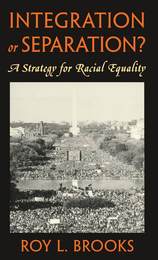 Integration or Separation?: A Strategy for Racial Equality
Roy L. Brooks
Harvard University Press, 1996 Integrated in principle, segregated in fact: is this the legacy of fifty years of "progress" in American racial policy? Is there hope for much better? Roy L. Brooks, a distinguished professor of law and a writer on matters of race and civil rights, says with frank clarity what few will admit--integration hasn't worked and possibly never will. Equally, he casts doubt on the solution that many African-Americans and mainstream whites have advocated: total separation of the races. This book presents Brooks's strategy for a middle way between the increasingly unworkable extremes of integration and separation.
Limited separation, the approach Brooks proposes, shifts the focus of civil rights policy from the group to the individual. Defined as cultural and economic integration within African-American society, this policy would promote separate schooling, housing, and business enterprises where needed to bolster the self-sufficiency of the community, without trammeling the racial interests of individuals inside or outside of the group, and without endangering the idea of a shared Americanness. But all the while Brooks envisions African-American public schools, businesses, and communities redesigned to serve the enlightened self-interest of the individual. Unwilling to give up entirely on racial integration, he argues that limited separation may indeed lead to improved race relations and, ultimately, to healthy integration.
This book appears at a crucial time, as Republicans dismantle past civil rights policies and Democrats search for new ones. With its alternative strategy and useful policy ideas for bringing individual African-Americans into mainstream society as first-class citizens, Integration or Separation? should influence debate and policymaking across the spectra of race, class, and political persuasion.
 Integrations: The Struggle for Racial Equality and Civic Renewal in Public Education
Lawrence Blum and Zoë Burkholder
University of Chicago Press, 2021 The promise of a free, high-quality public education is supposed to guarantee every child a shot at the American dream. But our widely segregated schools mean that many children of color do not have access to educational opportunities equal to those of their white peers. In Integrations, historian Zoë Burkholder and philosopher Lawrence Blum investigate what this country’s long history of school segregation means for achieving just and equitable educational opportunities in the United States.
Integrations focuses on multiple marginalized groups in American schooling: African Americans, Native Americans, Latinxs, and Asian Americans. The authors show that in order to grapple with integration in a meaningful way, we must think of integration in the plural, both in its multiple histories and in the many possible definitions of and courses of action for integration. Ultimately, the authors show, integration cannot guarantee educational equality and justice, but it is an essential component of civic education that prepares students for life in our multiracial democracy.
Integrative Alexander Technique Practice for Performing Artists: Onstage Synergy
Cathy Madden
Intellect Books, 2014 An educational method used to improve performance, the Alexander Technique teaches people to replace unnecessary muscular and mental effort with consciously coordinated responses, maximizing effectiveness while also relieving, if necessary, any chronic stiffness or stress. Integrative Alexander Technique Practice for Performing Artists presents the empirical research of Cathy Madden, a teacher and coach with more than thirty-five years of experience with the technique. She addresses common concerns, such as concentration, relaxation, discipline-specific techniques, warm-ups, performer/audience relationships, stage fright, and critical responses, and explores the role of the senses, emotions, learned behavior, human consciousness studies, and neuroscience in the application of the techniques.
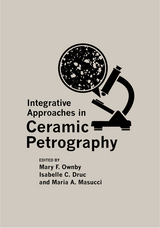 Integrative Approaches in Ceramic Petrography
Edited by Mary Ownby, Isabelle Druc, and Maria Masucci
University of Utah Press, 2016 Ceramic petrography, a microscopic examination of the mineral content and structure within ceramic thin sections, reveals the origin and movement of pottery and sheds light on the technology of the artifact. Practiced by archaeologists since the 1930s, ceramic petrography was less commonly practiced until recently. Integrative Approaches in Ceramic Petrography highlights new results from this field and incorporates it prominently within current archaeological work. Thirteen papers cover a broad spectrum of regional and temporal contexts with case studies that provide practical examples combining petrography with scientific, ethnographic, and experimental methods. The varied uses of ceramic petrography and the insights it has generated, illustrate the significance of this method for understanding past societies and the volume’s conclusion provides an astute overview of the field.
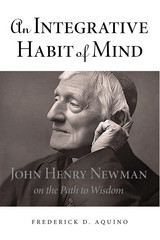 An Integrative Habit of Mind: John Henry Newman on the Path to Wisdom
Frederick D. Aquino
Northern Illinois University Press, 2012
Searching for better ways to inspire people to pursue wisdom, Frederick D. Aquino argues that teachers and researchers should focus less on state-of-the-art techniques and learning outcomes and instead pay more attention to the intellectual formation of their students. We should, Aquino contends, encourage the development of an integrative habit of mind, which entails cultivating the capacity to grasp how various pieces of data and areas of inquiry fit together and to understand how to apply this information to new situations.
To fully explore this notion, An Integrative Habit of Mind brings the work of the great religious figure and educator John Henry Newman into fruitful conversation with recent philosophical developments in epistemology, cognition, and education. Aquino unearths some crucial but neglected themes from Newman’s writings and carries them forward into the contemporary context, revealing how his ideas can help us broaden our horizons, render apt judgments, and better understand our world and how we think about it.
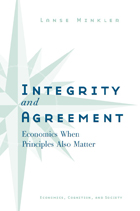 Integrity and Agreement: Economics When Principles Also Matter
Lanse Minkler
University of Michigan Press, 2009 "Two impressive features of this book are its clarity of purpose and the breadth of disciplinary resources to which it appeals."
---Geoffrey Brennan, Professor of Economics, Australian National University "Facing massive evidence that people do not act generally as self-regarding payoff maximizers, economists have become increasingly interested in issues of cooperation, altruism, identity, and morality. Lanse Minkler's contribution is particularly important because of his powerful argument that the evidence of cooperation cannot be explained adequately by a more complicated preference function. A disposition for honesty is not simply a matter of preference---it is an issue of personal integrity, identity, and commitment. This has major implications. In particular we have to reconstruct the theory of the firm from first principles. No economist committed to the pursuit of truth should ignore this volume."
---Geoffrey Hodgson, Research Professor in Business Studies, University of Hertfordshire, United Kingdom, and Editor in Chief of the Journal of Institutional Economics "This is an interesting account of the role of integrity---preference-integrity and commitment-integrity---on economic behavior. While drawing knowledge from traditional subfields of economics, it also includes insights gleaned from psychology and philosophy, showing their effects in varied areas such as political behavior, the employment relation, religion, and human rights. In this exciting volume Lanse Minkler does an excellent job of incorporating various newer concepts of fairness and integrity into economic analysis."
---Ernst Fehr, Professor and Head of the Chair of Microeconomics and Experimental Economic Research and Director of the Institute for Empirical Research in Economics, University of Zurich Social scientists who treat humans as rational beings driven exclusively by self-interest ignore a key factor shaping human behavior: the influence of moral principles. Starting with the elementary principle "lying is wrong," economic theorist Lanse Minkler examines the ways in which a sense of morality guides real-life decision making. Whether one feels committed to specific or general moral principles, Minkler explains, integrity demands consistently acting on that commitment. Because truthfulness is the most basic moral principle, integrity means honesty. And honesty extends beyond truth-telling. It requires good faith when entering an agreement and then standing by one's word. From this premise, Minkler explores the implications of integrity for contracts between buyers and sellers and understandings between employers and employees. He also finds a role for integrity in an individual's religious vows, an elected official's accountability to constituents, and a community's obligation to human rights. Integrity and Agreement reintroduces morality as a factor for economists, sociologists, psychologists, and political scientists to consider in their efforts to comprehend human behavior. Lanse Minkler is Associate Professor of Economics at the University of Connecticut.
 Integrity in Health Care Institutions: Humane Environments for Teaching, Inquiry, and Healing
Ruth Ellen Bulger
University of Iowa Press, 1990 The twelve essays in this stimulating volume, written by health care professionals and others working with the important issue of institutional ethics, focus on the world of academic health centers and provide rich, informed commentaries on significant problems integral to the character and work of those centers. Daniel Steiner demonstrates how the viability of independent research may be threatened by university liaisons with industry. Donald Frederickson traces the history of the National Institutes of Health response to the ethical challenges in clinical investigation and fetal research. Edmund Pellegrino recommends ways in which health-related institutions may translate their concern into action. Robert Coles examines the tensions between institutional and personal values in a very provocative way. Other directions are explored by essayists Roger Bulger, Stephen Toulmin, H. Tristram Engelhardt, Kim Dunn, Mitchell Rabkin, James Haughton, Lawrence Green, and the editors themselves. Every essay in this wide-ranging collection reveals the implications and effects of institutional values. The end result is a clear picture of conflicts of values: ethical, social, economic, ethnic, cultural, and pedagogic. Integrity in Health Care Institutions points out the need for a deliberate attempt to sort out the values of institutions and, when they are fully and clearly displayed, to use priorities as a guide to satisfying the obligations of academic health centers to those who work within their walls; to the patients, students, scientists, and teachers they serve; and to society in general. Physicians and nurses, hospital and university administrators, attorneys, sociologists, and everyone concerned about the moral interaction between institutions and individuals will want to read this book.
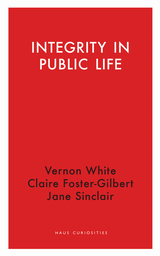 Integrity in Public Life
Vernon White, Claire Foster-Gilbert, and Jane Sinclair
Haus Publishing, 2019 Good governance is a fundamental value in the United Kingdom, and its citizens are entitled to expect that public officials, both elected and non-elected, behave according to the highest standards of ethical behavior. Of course, these aspirations alone are not enough to root out corruption in government. In order for integrity in public life to be maintained, the core principles underlying these expectations must be constantly examined and strengthened. This new volume, published in collaboration with the Westminster Abbey Institute, explores ways in which public service institutions can maintain integrity on both the institutional and the individual level. While keeping the power of the individual in mind, the authors also illustrate the critical role institutions play in upholding values when the moral compass of individuals in power fails. Integrity in Public Life provides an essential guide to integrity, seeking to answer the fundamentals of what integrity means in public life and why it holds such a critical role in the constitution of Britain.
 The Integrity of the Body: A Discussion of Modern Immunological Ideas
F. M. Burnet
Harvard University Press Geneticists and biochemists, particularly, have realized the special potentialities of antibodies as biologically labeled proteins that help to throw light on the process whereby genetic information carried in the chromosomes is eventually manifested in the synthesis of the proteins needed for the functioning of the organism. There are in addition many specialized applications of immunology in the other biological sciences.
F. M. Burnet describes with characteristic vividness the kinds of problems with which immunology is concerned today and the methods by which it seeks answers to them. Although he gives particular emphasis to the clonal-selection theory of immunity, of which he is the originator, he frankly says that “because it is so inherently simple, it is probably wrong.” He explains other theories of immunity as well. He discusses both nonmedical and medical applications of immunology and devotes several chapters to allergic disease and autoimmune disease. He concludes with some personal speculations into the deeper problems of biology—for instance, a somatic mutation theory of aging, in which immunology may be expected eventually to be of service.
 The Intellect Handbook of Dance Education Research
Edited by Lynnette Young Overby, Billie Lepczyk, and Jill Green
Intellect Books, 2025 A global exploration of dance education research, its methodologies, and its impact on the field.
The Intellect Handbook of Dance Education Research is a necessary resource for students, educators, and advocates, offering a broad survey of research methodologies alongside real-world applications from across the globe. This volume brings together voices from both seasoned and emerging scholars, highlighting the diversity of dance research in countries including Korea, South Africa, Jamaica, India, Brazil, Slovenia, and beyond.
Divided into four parts, the book first examines foundational research methodologies, spanning mixed-method approaches as well as innovative techniques like portraiture and a/r/tography. The second section presents dance education research in practice, exploring history, choreography, and community-based initiatives. The third part showcases international perspectives, offering snapshots of research traditions from contrasting cultural contexts. Finally, the fourth section elaborates on the role of dance in social justice, illustrating how movement-based research can drive cultural and societal change.
A vital tool for researchers, policymakers, and educators alike, this handbook underscores the significance of dance as a transformative force in education, fostering collaboration and meaningful impact in diverse communities.
 The Intellect Handbook of Documentary
Edited by Kate Nash and Deane Williams
Intellect Books, 2025 The growth of documentaries and their role in culture, activism, and social impact.
The Intellect Handbook of Documentary is an important go-to resource for practitioners, scholars, and students in this burgeoning field. It tackles key topics and debates including the role of documentary in post-truth culture, the rise of streaming giants, and the implications for national documentary cultures, as well as the shifting, increasingly hybrid, practices of documentary activism and the professionalization of impact. Featuring work by key figures in international documentary scholarship and talented emerging scholars, the Handbook is a landmark publication for documentary studies in the twenty-first century.
The Handbook is broad in its scope, incorporating historical, theoretical, empirical, and practical scholarship. It is organized around ten key themes and debates: What and where is documentary (studies); documentary in an age of epistemic uncertainty; documentary histories; documentary and the archive; audio and visualities; documentary relationalities; beyond the Anthropocene; digital and documentary practices; documentary and (new) politics; and a golden age of documentary distribution and funding. Importantly, the Handbook incorporates the voices and practices of practitioners from the Global South, challenging the dominance of Western voices in documentary scholarship.
The Intellect Handbook of Popular Music Methodologies
Edited by Mike Dines, Shara Rambarran, and Gareth Dylan Smith
Intellect Books, 2025 An extensive overview of popular music methodologies.
The Intellect Handbook of Popular Music Methodologies attempts a comprehensive overview of methodological approaches within the field of popular music studies. Alongside contributions from key thinkers already established in popular music studies, the strength of the collection lies in its inclusion of many new and emerging writers in the field. Therefore, the collection incorporates a wide range of practitioners, pedagogues, and academics from across the disciplines, and thus draws from a diversity of methodological approaches. As a result, this will be the first comprehensive handbook of popular music methodologies.
 The Intellective Space: Thinking beyond Cognition
Laurent Dubreuil
University of Minnesota Press, 2015 The Intellective Space explores the nature and limits of thought. It celebrates the poetic virtues of language and the creative imperfections of our animal minds while pleading for a renewal of the humanities that is grounded in a study of the sciences. According to Laurent Dubreuil, we humans both say more than we think and think more than we say. Dubreuil’s particular interest is the intellective space, a space where thought and knowledge are performed and shared. For Dubreuil, the term “cognition” refers to the minimal level of our mental operations. But he suggests that for humans there is an excess of cognition due to our extensive processing necessary for verbal language, brain dynamics, and social contexts. In articulating the intellective, Dubreuil includes “the productive undoing of cognition.” Dubreuil grants that cognitive operations take place and that protocols of experimental psychology, new techniques of neuroimagery, and mathematical or computerized models provide access to a certain understanding of thought. But he argues that there is something in thinking that bypasses cognitive structures. Seeking to theorize with the sciences, the book’s first section develops the “intellective hypothesis” and points toward the potential journey of ideas going beyond cognition, after and before computation. The second part, “Animal Meditations,” pursues some of the consequences of this hypothesis with regard to the disparaged but enduring project of metaphysics, with its emphasis on categories such as reality, humanness, and the soul.
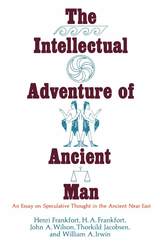 The Intellectual Adventure of Ancient Man: An Essay of Speculative Thought in the Ancient Near East
Henri Frankfort, H. A. Frankfort, John A. Wilson, Thorkild Jacobsen, and William A. Irwin
University of Chicago Press, 1946 The people in ancient times the phenomenal world was teeming with life; the thunderclap, the sudden shadow, the unknown and eerie clearing in the wood, all were living things. This unabridged edition traces the fascinating history of thought from the pre-scientific, personal concept of a "humanized" world to the achievement of detached intellectual reasoning.
The authors describe and analyze the spiritual life of three ancient civilizations: the Egyptians, whose thinking was profoundly influenced by the daily rebirth of the sun and the annual rebirth of the Nile; the Mesopotamians, who believed the stars, moon, and stones were all citizens of a cosmic state; and the Hebrews, who transcended prevailing mythopoeic thought with their cosmogony of the will of God. In the concluding chapter the Frankforts show that the Greeks, with their intellectual courage, were the first culture to discover a realm of speculative thought in which myth was overcome.
 The Intellectual Appeal of Catholicism and the Idea of a Catholic University
Mark W. Roche
University of Notre Dame Press, 2003 "A deeply thoughtful articulation of an enduring and appealing ideal. It is an ideal with a resonance beyond the world of Catholic higher education for all in the academy who still respond to the beckoning vision of the ultimate unity of all human knowing and who view it, indeed, as a necessary inspiration if we are to succeed in according to our intellectual activities the sort of seriousness and moral significance they properly deserve." —Francis Oakley, President Emeritus, Williams College
"There is a real need, indeed an absolute necessity, for a Catholic university that is true to its religious values. By so being, it makes other, non-Catholic institutions that much better." —E. Gordon Gee, Chancellor, Vanderbilt University
"Dean Roche has done a rare thing. He has articulated a sharp and clear Catholic theology of Christian higher education. What has been implicit in the practice of great Catholic universities has now been made explicit in this fine essay." —Robert Benne, author of Quality with Soul: How Six Premier Colleges and Universities Keep Faith with Their Religious Traditions
"Catholic identity will mean nothing in the world of higher education if it lacks a genuine intellectual dimension. Mark Roche understands that fundamental fact, tackles the problem directly, and deals with it cogently." —Philip Gleason, author of Contending with Modernity: Catholic Higher Education in the Twentieth Century
Intellectual Appetite: A Theological Grammar
Paul J. Griffiths
Catholic University of America Press, 2009 The appetite for knowledge--wanting to know things--is very strong in humans. Some will sacrifice all other goods (sex, power, food, life itself) for it. But this is not a simple appetite, and this book treats some of its complications, deformations, beauties, and intensities.
 Intellectual Commons and the Law: A Normative Theory for Commons-Based Peer Production
Antonios Broumas
University of Westminster Press, 2020 ‘With clarity and sophistication, Antonios Broumas presents a bold new theory of intellectual commons and powerful arguments for a new body of supportive law. This book not only reveals the misleading logic of intellectual property law in our time; it reveals the rich possibilities for constructive change that legally protected commoning can bring. Highly recommended!’ — David Bollier, Director, Reinventing the Commons Program, Schumacher Center for a New Economics. ‘Liberating the Intellectual Commons from the fetters of capital accumulation and appropriation, would give us a renaissance of creative energies and empowered communities: exactly what the world needs to move away from the social and ecological devastations of our times. This book is a thoughtful and compelling argument for making this possible through the works of the law and the redesign of public domain as a common space.’ — Massimo De Angelis, Professor of Political Economy and Social Change, Co-director of the Centre for Social Justice and Change, University of East London. ‘In this pioneering book, Antonios Broumas argues that philosophically, morally, politically and economically we are in urgent need of a new legal regime that recognizes the intellectual commons, peer production and sharing as the primary practices of intellectual production, distribution and consumption. I cannot imagine a more urgent task today. A legally protected intellectual commons will lead to greater scientific and cultural innovation and creativity and will lead to an urgently needed second Enlightenment. This book should be read by lawyers, critical theorists, economists and the many professionals of science, culture and the academy.’ — Costas Douzinas, Professor of Law, Birkbeck, University of London. ‘Antonios Broumas’ book is an excellent critical analysis of the cultural commons and a must-read for everyone interested in understanding what the commons, the cultural commons, and the digital commons are all about. This work brilliantly outlines the foundations of an empirically grounded critical theory of the commons and the cultural commons in the context of the interactions of law and society.’ — Christian Fuchs, Professor of Media and Communication Studies, author of Communication and Capitalism: A Critical Theory (2020). ‘Broumas takes us on a spellbinding tour of how and why the law could and should change to accommodate the creative multitude, which engages into an emerging mode of production. He tells a vibrant story that makes us shout: “Lawmakers of the world, unite!”’ — Vasilis Kostakis, Professor of P2P Governance, Tallinn University of Technology, Faculty Associate at Harvard Law School. At the cutting edge of contemporary wealth creation people form self-governed communities of collaborative innovation in conditions of relative equipotency and produce resources with free access to all. The emergent intellectual commons have the potential to commonify intellectual production and distribution, unleash human creativity through collaboration and democratise innovation with wider positive effects for our societies. Contemporary intellectual property laws fail to address this potential. We are, therefore, in pressing need of an institutional alternative beyond the inherent limitations of intellectual property law. This book offers an overall analysis of the moral significance of the intellectual commons and outlines appropriate modes for their regulation. Its principal thesis is that our legal systems are in need of an independent body of law for the protection and promotion of the intellectual commons, in parallel to intellectual property law. In this context, the author of the book proposes the reconstruction of the doctrine of the public domain and the exceptions and limitations of exclusive intellectual property rights into an intellectual commons law, which will underpin a vibrant non-commercial zone of creativity and innovation in intellectual production, distribution and consumption alongside commodity markets enabled by intellectual property law.
The Intellectual Crisis in American Public Administration
Vincent Ostrom
University of Alabama Press, 2007 This revised and expanded third edition extends Ostrom’s analysis to account for the most resent developments in American politics, including those of the Clinton and Bush administrations.
The Intellectual Dynamism of the High Middle Ages
Clare Monagle
Amsterdam University Press, 2021 The essays in The Intellectual Dynamism of the High Middle Ages pay tribute to the work and impact of Constant J. Mews, in spirit and in content, revealing a nuanced and integrated vision of the intellectual history of the medieval West. Mews's groundbreaking work has revealed the wide world of medieval letters: looking beyond the cathedral and the cloister for his investigations, and taking a broad view of intellectual practice in the Middle Ages, Mews has demanded that we expand our horizons as we explore the history of ideas. Alongside his cutting-edge work on Abelard, he has been a leader in the study of medieval women writers, paying heed to Hildegard and Heloise in particular. In Mews' Middle Ages, the world of ideas always belongs to a larger world: one that is cultural, gendered, and politicized.
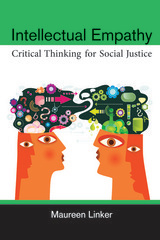 Intellectual Empathy: Critical Thinking for Social Justice
Maureen Linker
University of Michigan Press, 2014 Intellectual Empathy provides a step-by-step method for facilitating discussions of socially divisive issues. Maureen Linker, a philosophy professor at the University of Michigan–Dearborn, developed Intellectual Empathy after more than a decade of teaching critical thinking in metropolitan Detroit, one of the most racially and economically divided urban areas, at the crossroads of one of the Midwest’s largest Muslim communities. The skills acquired through Intellectual Empathy have proven to be significant for students who pursue careers in education, social work, law, business, and medicine. Now, Linker shows educators, activists, business managers, community leaders—anyone working toward fruitful dialogues about social differences—how potentially transformative conversations break down and how they can be repaired. Starting from Socrates’s injunction know thyself, Linker explains why interrogating our own beliefs is essential. In contrast to traditional approaches in logic that devalue emotion, Linker acknowledges the affective aspects of reasoning and how emotion is embedded in our understanding of self and other. Using examples from classroom dialogues, online comment forums, news media, and diversity training workshops, readers learn to recognize logical fallacies and critically, yet empathically, assess their own social biases, as well as the structural inequalities that perpetuate social injustice and divide us from each other.
Intellectual Foundations of the Nicaraguan Revolution
By Donald C. Hodges
University of Texas Press, 1986 In this critical study of the thought of Augusto Cesar Sandino and his followers, Donald C. Hodges has discovered a coherent ideological thread and political program, which he succeeds in tracing to Mexican and Spanish sources. Sandino's strong religious inclination in combination with his anarchosyndicalist political ideology established him as a religious seer and moral reformer as well as a political thinker and is the prototype of the curious blend of Marxism and Christianity of the late twentieth-century Nicaraguan government, the Frente Sandinista de Liberación Nacional.
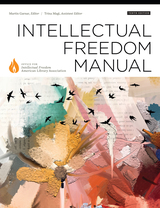 Intellectual Freedom Manual
Trina Magi
American Library Association, 2021 The newest edition of the Intellectual Freedom Manual is more than simply an update of a foundational text that has served as a crucial resource for more than four decades. It is a living document that serves as the authoritative reference for day-to-day guidance on maintaining free and equal access to information for all people. Whether you’re developing or revising policies, on-boarding new staff or trustees, responding to challenges and controversies, or studying librarianship, you’ll find this an indispensable resource, with features such as - ALA policy statements, approved by committees and Council, articulating core intellectual freedom principles and best practices;
- 8 new interpretations of the Library Bill of Rights, which address urgent issues like internet filtering, public performances, political activity, religion, and equity, diversity, and inclusion;
- “Issues at a Glance” sidebars which present key concepts, points of law, tips, and questions for reflection;
- expanded content about developing library policies that support intellectual freedom;
- updated information on censorship of library programs, displays, and databases;
- “Advocacy and Assistance,” a section offering concrete guidance when you’re called on to talk to the media or meet with legislators;
- Deeper Look essays which examine the laws related to library operations;
- advice on when to call the police, when not to, and how to handle personally identifiable information when they arrive; and
- an expanded glossary.
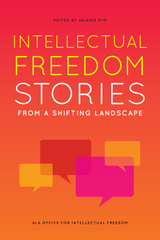 Intellectual Freedom Stories from a Shifting Landscape
Valerie Nye
American Library Association, 2020 Intellectual freedom is a complex concept that democracies and free societies around the world define in different ways but always strive to uphold. And ALA has long recognized the crucial role that libraries play in protecting this right. But what does it mean in practice? How do library workers handle the ethical conundrums that often accompany the commitment to defending it? Rather than merely laying out abstract policies and best practices, this important new collection gathers real-world stories of intellectual freedom in action to illuminate the difficulties, triumphs, and occasional setbacks of advocating for free and equal access to information for all people in a shifting landscape. Offering insight to LIS students and current practitioners on how we can advance the profession of librarianship while fighting censorship and other challenges, these personal narratives explore such formidable situations as - presenting drag queen story times in rural America;
- a Black Lives Matter “die-in” at the undergraduate library of the University of Wisconsin-Madison;
- combating censorship at a prison library;
- hosting a moderated talk about threats to modern democracy that included a neo-Nazi spokesman;
- a provocative exhibition that triggered intimidating phone calls, emails, and a threat to burn down an art library;
- calls to eliminate non-Indigenous children’s literature from the collection of a tribal college library; and
- preserving patrons’ right to privacy in the face of an FBI subpoena.
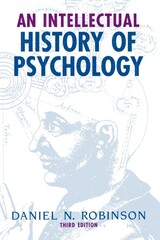 An Intellectual History of Psychology
Daniel N. Robinson
University of Wisconsin Press, 1995 An Intellectual History of Psychology, already a classic in its field, is now available in a concise new third edition. It presents psychological ideas as part of a greater web of thinking throughout history about the essentials of human nature, interwoven with ideas from philosophy, science, religion, art, literature, and politics.
Daniel N. Robinson demonstrates that from the dawn of rigorous and self-critical inquiry in ancient Greece, reflections about human nature have been inextricably linked to the cultures from which they arose, and each definable historical age has added its own character and tone to this long tradition. An Intellectual History of Psychology not only explores the most significant ideas about human nature from ancient to modern times, but also examines the broader social and scientific contexts in which these concepts were articulated and defended. Robinson treats each epoch, whether ancient Greece or Renaissance Florence or Enlightenment France, in its own terms, revealing the problems that dominated the age and engaged the energies of leading thinkers.
Robinson also explores the abiding tension between humanistic and scientific perspectives, assessing the most convincing positions on each side of the debate. Invaluable as a text for students and as a stimulating and insightful overview for scholars and practicing psychologists, this volume can be read either as a history of psychology in both its philosophical and aspiring scientific periods or as a concise history of Western philosophy’s concepts of human nature.
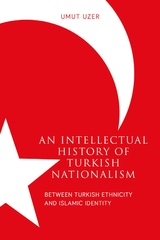 An Intellectual History of Turkish Nationalism: Between Turkish Ethnicity and Islamic Identity
Umut Uzer
University of Utah Press, 2016 In this book, Umut Uzer examines the ideological evolution and transformation of Turkish nationalism from its early precursors to its contemporary protagonists. Turkish nationalism erupted onto the world stage in the late nineteenth and early twentieth centuries, as Greeks, Armenians, and other minority groups within the Ottoman Empire began to seek independence. Partly in response to the rising nationalist voices of these groups, Turkish intellectuals began propagating Turkish nationalism through academic as well as popular books, and later associations published semipropagandist journals with the support of the Unionist and Kemalist governments.
While predominantly a textual analysis of the primary sources written by the nationalists, this volume takes into account how political developments influenced Turkish nationalism and also tackles the question of how an ideology that began as a revolutionary, progressive, forward-looking ideal eventually transformed into one that is conservative, patriarchal, and nostalgic to the Ottoman and Islamic past. Between Islamic and Turkish Identity is the first book in any language to comprehensively analyze Turkish nationalism with such scope and engagement with primary sources; it aims to dissect the phenomenon in all its manifestations.
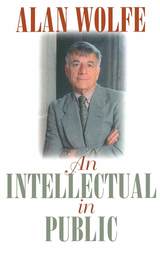 An Intellectual in Public
Alan Wolfe
University of Michigan Press, 2004 A new collection of essays from one of the most courageous and honest thinkers writing today
". . . proof that the spirit of the free-ranging public intellectual is still very much alive."
-Newsday
"Alan Wolfe is one of liberalism's last and most loyal sons. His mind is naturally decent and diversified; large enough and fair enough to contain both conviction and doubt. His profound respect for real people does not interfere with his profound respect for real thought. The criticism that he practices is, I fear, a dying art, but it is also one of the glories of American democracy."
-Leon Wieseltier, New Republic
"Alan Wolfe is one of America's indispensable essayists. On a broad range of topics-race, religion, politics, the marketplace, the university, and more-he combines a scholar's erudition with a historian's feel for the past and a journalist's keen attunement to the shifting patterns of the current scene. Above all he is a true writer, graceful but fearless, who ponders the deep questions so often ignored in the clamor of our ongoing civic conversation. Anyone who wonders what the term 'public intellectual' really means will find the answer-in fact many answers-in this scintillating collection."
-Sam Tanenhaus, Vanity Fair
 The Intellectual Legacy of Herman Dooyeweerd (1894-1977): A Hopeful Philosophy for our Time
Maarten Verkerk
Amsterdam University Press, 2025 Herman Dooyeweerd (1894-1977), a renowned philosopher and legal scholar, has been regarded as one of the most original philosophers the Netherlands has ever produced. In 1935, he published his seminal work, A New Critique of Theoretical Thought, which offers an in-depth analysis of the foundations of culture and science. Dooyeweerd develops a sophisticated and impressive conceptual framework to analyse reality. He demonstrates that every philosophy, all science, and every political ideology is driven by underlying religious or worldview perspectives.
The work of Herman Dooyeweerd is currently attracting global interest. From the United States to Korea, from New Zealand to Brazil, and from the United Kingdom to South Africa, professionals across various disciplines—philosophers, engineers, politicians, economists, and others—are expanding upon his ideas within their respective fields. At the same time, his work is becoming increasingly relevant as contemporary society displays characteristics reminiscent of those observed in European culture a century ago. The Intellectual Legacy of Herman Dooyeweerd (1894-1977): A Hopeful Philosophy for our Time introduces his most significant concepts and numerous examples of their contemporary applications.
 The Intellectual Legacy of Herman Dooyeweerd (1894-1977): A Hopeful Philosophy for our Time
Maarten Verkerk
Amsterdam University Press, 2025 Herman Dooyeweerd (1894-1977), a renowned philosopher and legal scholar, has been regarded as one of the most original philosophers the Netherlands has ever produced. In 1935, he published his seminal work, A New Critique of Theoretical Thought, which offers an in-depth analysis of the foundations of culture and science. Dooyeweerd develops a sophisticated and impressive conceptual framework to analyse reality. He demonstrates that every philosophy, all science, and every political ideology is driven by underlying religious or worldview perspectives.
The work of Herman Dooyeweerd is currently attracting global interest. From the United States to Korea, from New Zealand to Brazil, and from the United Kingdom to South Africa, professionals across various disciplines—philosophers, engineers, politicians, economists, and others—are expanding upon his ideas within their respective fields. At the same time, his work is becoming increasingly relevant as contemporary society displays characteristics reminiscent of those observed in European culture a century ago. The Intellectual Legacy of Herman Dooyeweerd (1894-1977): A Hopeful Philosophy for our Time introduces his most significant concepts and numerous examples of their contemporary applications.
The Intellectual Life
A. G. Sertillanges
Catholic University of America Press, 1992 "Fr. Sertillanges's teachings are as timeless as any truths which describe the genuine nature of things. . . . This book is highly recommended not only for intellectuals, but also for students and those discerning their vocation in life."—New Oxford Review
"[This] is above all a practical book. It discusses with a wealth of illustration and insight such subjects as the organization of the intellectual worker's time, materials, and his life; the integration of knowledge and the relation of one's specialty to general knowledge; the choice and use of reading; the discipline of memory; the taking of notes, their classification and use; and the preparation and organization of the final production."—The Sign
Intellectual Life in America: A History
Lewis Perry
University of Chicago Press, 1989 This historical study of intellectuals asks, for every period, who they were, how important they were, and how they saw themselves in relation to other Americans. Lewis Perry considers intellectuals in their varied historical roles as learned gentlemen, as clergymen and public figures, as professionals, as freelance critics, and as a professoriate.
Looking at the changing reputation of the intellect itself, Perry examines many forms of anti-intellectualism, showing that some of these were encouraged by intellectuals as surely as by their antagonists. This work is interpretative, critical, and highly provocative, and it provides what is all too often missing in the study of intellectuals—a sense of historical orientation.
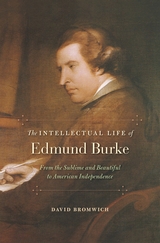 The Intellectual Life of Edmund Burke: From the Sublime and Beautiful to American Independence
David Bromwich
Harvard University Press, 2014 David Bromwich’s portrait of statesman Edmund Burke (1730–1797) is the first biography to attend to the complexity of Burke’s thought as it emerges in both the major writings and private correspondence. The public and private writings cannot be easily dissociated, nor should they be. For Burke—a thinker, writer, and politician—the principles of politics were merely those of morality enlarged. Bromwich reads Burke’s career as an imperfect attempt to organize an honorable life in the dense medium he knew politics to be.
This intellectual biography examines the first three decades of Burke’s professional life. His protest against the cruelties of English society and his criticism of all unchecked power laid the groundwork for his later attacks on abuses of government in India, Ireland, and France. Bromwich allows us to see the youthful skeptic, wary of a social contract based on “nature”; the theorist of love and fear in relation to “the sublime and beautiful”; the advocate of civil liberty, even in the face of civil disorder; the architect of economic reform; and the agitator for peace with America. However multiple and various Burke’s campaigns, a single-mindedness of commitment always drove him.
Burke is commonly seen as the father of modern conservatism. Bromwich reveals the matter to be far more subtle and interesting. Burke was a defender of the rights of disfranchised minorities and an opponent of militarism. His politics diverge from those of any modern party, but all parties would be wiser for acquaintance with his writing and thoughts.
 The Intellectual Lives of Children
Susan Engel
Harvard University Press, 2020 “A remarkable book. Whether you are an educator, parent, or simply a curious reader, you will come to see, hear, and understand children in new ways.”
—Howard Gardner, author of Multiple Intelligences
Adults easily recognize children’s imagination at work as they play. Yet most of us know little about what really goes on inside their heads as they encounter the problems and complexities of the world around them. Susan Engel brings together an extraordinary body of research to explain how toddlers, preschoolers, and elementary-aged children think.
A young girl’s bug collection reveals how children ask questions and organize information. Watching a boy scoop mud illuminates the process of invention. When a child ponders the mystery of death, we witness how ideas are built. But adults shouldn’t just stand around watching. When parents are creative, it can rub off. Engel shows how parents and teachers can stimulate children’s curiosity by presenting them with mysteries to solve, feeding their sense of mastery and nourishing their natural hunger to learn.
“A fascinating read for parents who wonder, simply, what is my child thinking? Why do they love collecting? Where did that idea come from? A celebration of children’s innovation and sense of wonder.”
—Emily Oster, author of Expecting Better
“Combining insight, scientific acumen, and exquisite narrative, The Intellectual Lives of Children allows readers to peer into the minds of infants, toddlers, and preschoolers as they explore and learn in everyday moments, emphasizing what constitutes real learning.”
—Kathy Hirsh-Pasek, Science
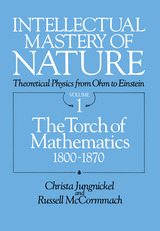 Intellectual Mastery of Nature. Theoretical Physics from Ohm to Einstein, Volume 1: The Torch of Mathematics, 1800 to 1870
Christa Jungnickel and Russell McCormmach
University of Chicago Press, 1986 Christina Jungnickel and Russell McCormmach have created in these two volumes a panoramic history of German theoretical physics. Bridging social, institutional, and intellectual history, they chronicle the work of the researchers who, from the first years of the nineteenth century, strove for an intellectual mastery of nature.
Volume 1 opens with an account of physics in Germany at the beginning of the nineteenth century and of German physicists' reception of foreign mathematical and experimental work. Jungnickel and McCormmach follow G. S. Ohm, Wilhelm Weber, Franz Neumann, and others as these scientists work out the new possibilities for physics, introduce student laboratories and instruction in mathematical physics, organize societies and journals, and establish and advance major theories of classical physics. Before the end of the nineteenth century, German physics and its offspring, theoretical physics, had acquired nearly their present organizational forms. The foundations of the classical picture of the physical world had been securely laid, preparing the way for the developments that are the subject of volume 2.
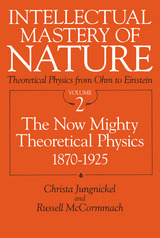 Intellectual Mastery of Nature. Theoretical Physics from Ohm to Einstein, Volume 2: The Now Mighty Theoretical Physics, 1870 to 1925
Christa Jungnickel and Russell McCormmach
University of Chicago Press, 1986 Winner of the 1987 Pfizer Award of the History of Science Society
"A majestic study of a most important spoch of intellectual
history."—Brian Pippard, Times Literary Supplement
"The authors' use of archival sources hitherto almost
untouched gives their story a startling vividness. These volumes
are among the finest works produced by historians of physics."—Jed
Z. Buchwald, Isis
"The authors painstakingly reconstruct the minutiae of
laboratory budgets, instrument collections, and student numbers;
they disentangle the intrigues of faculty appointments and the
professional values those appointments reflected; they explore
collegial relationships among physicists; and they document the
unending campaign of scientists to wring further support for
physics from often reluctant ministries."—R. Steven Turner, Science
"Superbly written and exhaustively researched."—Peter Harman,
Nature
 The Intellectual Origins of American Slavery: English Ideas in the Early Modern Atlantic World
John Samuel Harpham
Harvard University Press, 2025 A landmark account of the origins of American slavery, revealing how ancient Roman ideas were used to defend the establishment of a slave empire in the English Atlantic world.
The period from 1550 to 1700 was critical in the development of slavery across the English Atlantic world. During this time, English discourse about slavery revolved around one central question: How could free persons be made into slaves? John Samuel Harpham shows that English authors found answers to this question in a tradition of ideas that stretched back to the ancient world, where they were most powerfully expressed in Roman law. These ideas, in turn, became the basis for the earliest defenses of American slavery.
The Roman tradition had located the main source of slavery in war: enslavement was the common fate of captives who otherwise faced execution. In early modern England, this account was incorporated into studies of the common law and influential natural rights theories by the likes of Hugo Grotius and John Locke. When Europeans started to publish firsthand accounts of Africa in the sixteenth century, these reports were thus received into a culture saturated with Roman ideas. Over time, English observers started to assert that the common customs of enslavement among the nations of Africa fit within the Roman model. Englishmen had initially expressed reluctance to take part in the Atlantic slave trade. But once assured that the slave trade could be traced back to customs they understood to be legitimate, they proved keen to profit from it.
An eloquent account of the moral logic that propelled the development of an immoral institution, The Intellectual Origins of American Slavery reveals the power of an overlooked tradition of ideas in the history of human bondage.
 Intellectual Politics in Post-Tiananmen China, Volume 16
Xudong Zhang
Duke University Press The essays in this special issue of Social Text explore the fields of cultural and intellectual production in post-Tiananmen China and address the discrepancy between the growth in critical studies of China and the virtually untouched terrain of China’s ideological-intellectual dimension. Creating a platform for further theoretical discussion about the ongoing struggle to bring about a new social system, the contributors grapple with the internal crisis or disorientation of the Chinese intellectual world as a distorted, but telling picture of the complexity of contemporary Chinese economics, politics, society, and culture. Essays offer a critical examination of the current state of Chinese intellectual discourse; a challenge to mainstream liberalism in China today and its commitment to democracy; a summary of reconsiderations of property rights, economic democracy, political participation, and the meaning of socialism in the age of flexible production; a reflection on the handover of Hong Kong in the context of a general discussion of Western colonialism in China; and an analysis of the rise of consumer nationalism and mass culture in China since the early 1990s. Intellectual Politics in Post-Tiananmen China sheds light on the evasive nature of Chinese society, and the contributors engage the Chinese problematic not only as a crisis but also as an ongoing historical dynamic. Contributors. Rey Chow, Zhiyuan Cui, Wang Hui, Gan Yang, Xudong Zhang
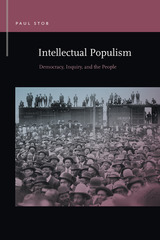 Intellectual Populism: Democracy, Inquiry, and the People
Paul Stob
Michigan State University Press, 2020 In response to denunciations of populism as undemocratic and anti-intellectual, Intellectual Populism argues that populism has contributed to a distinct and democratic intellectual tradition in which ordinary people assume leading roles in the pursuit of knowledge. Focusing on the Gilded Age and Progressive Era, the decades that saw the birth of populism in the United States, this book uses case studies of certain intellectual figures to trace the key rhetorical appeals that proved capable of resisting the status quo and building alternative communities of inquiry. As this book shows, Robert Ingersoll (1833–1899), Mary Baker Eddy (1821–1910), Thomas Davidson (1840–1900), Booker T. Washington (1856–1915), and Zitkála-Šá (1876–1938) deployed populist rhetoric to rally ordinary people as thinkers in new intellectual efforts. Through these case studies, Intellectual Populism demonstrates how orators and advocates can channel the frustrations and energies of the American people toward productive, democratic, intellectual ends.
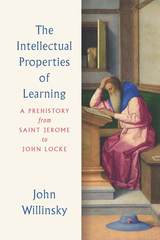 The Intellectual Properties of Learning: A Prehistory from Saint Jerome to John Locke
John Willinsky
University of Chicago Press, 2017 Providing a sweeping millennium-plus history of the learned book in the West, John Willinsky puts current debates over intellectual property into context, asking what it is about learning that helped to create the concept even as it gave the products of knowledge a different legal and economic standing than other sorts of property.
Willinsky begins with Saint Jerome in the fifth century, then traces the evolution of reading, writing, and editing practices in monasteries, schools, universities, and among independent scholars through the medieval period and into the Renaissance. He delves into the influx of Islamic learning and the rediscovery of classical texts, the dissolution of the monasteries, and the founding of the Bodleian Library before finally arriving at John Locke, whose influential lobbying helped bring about the first copyright law, the Statute of Anne of 1710. Willinsky’s bravura tour through this history shows that learning gave rise to our idea of intellectual property while remaining distinct from, if not wholly uncompromised by, the commercial economy that this concept inspired, making it clear that today’s push for marketable intellectual property threatens the very nature of the quest for learning on which it rests.
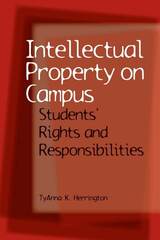 Intellectual Property on Campus: Students' Rights and Responsibilities
TyAnna K. Herrington
Southern Illinois University Press, 2010 What issues arise when students’ uses of intellectual materials are legally challenged, and how does the academic context affect them? What happens when users of intellectual property, either within or outside the academic structure, violate students’ rights to their intellectual products? In Intellectual Property on Campus, TyAnna K. Herrington addresses these concerns and more, clearing up the confusion often surrounding intellectual property law and its application in an academic setting. Filled with practical information and simple yet thorough explanations, this enlightening volume provides educators and students with a solid basis for understanding the broader impacts of legal and ethical dilemmas involving intellectual materials.
Herrington provides insight for students into how complex concepts such as patent, trademark, copyright, fair use, and plagiarism affect their work. She outlines the potential effects of the choices students make, as well as the benefits and limitations of legal protection for intellectual property, including the thorny issues of authorship and authority under the 1976 Copyright Act. Herrington also explores the topic of student collaboration—now very common on college campuses—and how it affects intellectual property issues and legal relationships, as well as the impact of new technologies, such as blogs, on student work in educational environments.
Intellectual Property on Campus also provides useful information for administrators and educators. In particular, Herrington investigates the possible ramifications of their pedagogical and policy choices, and examines in depth the responsibility of instructors to treat students’ intellectual property legally, ethically, and conscientiously. Cautioning educators about the limitations on their control over intellectual materials in an academic setting, Herrington encourages teachers to minimize their influence over student works, instead giving pupils more freedom to control their own creations.
The volume also investigates the rights, responsibilities, and limitations for users of intellectual property, as opposed to creators, especially as related to student or instructor use of copyrighted materials. Discussed in detail are such issues as fair use and the TEACH Act, as well as the often-intertwined areas of plagiarism, authorship, and copyright. In addition, Herrington addresses recent cultural developments regarding the use and creation of intellectual property by students and instructors.
Written in a jargon-free style that is easy to understand, Intellectual Property on Campus gives students, instructors, and administrators the information they need to navigate the intricate landscape of law and integrity in the realm of academic creation.
Intellectual Property Rights for Engineers
Vivien Irish
The Institution of Engineering and Technology, 2005 This fully revised and updated edition of Intellectual Property Rights for Engineers addresses recent developments in the area. The book explains the general principles behind the law protecting innovation, quoting cases from the engineering domain in order to clarify legal issues. Chapters outline the basic rights through automatic protection (copyright, design right) and registration systems (patent, registered design, trade mark), and also discusses the issues surrounding confidential information. The book clarifies precisely who owns the rights and how their use is constrained by EC law, and goes on to explain how to license or even litigate when necessary. Finally, strategic aspects for decision-making and management are discussed.
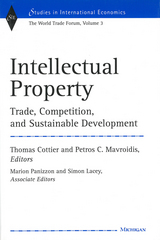 Intellectual Property: Trade, Competition, and Sustainable Development The World Trade Forum, Volume 3
Thomas Cottier and Petros C. Mavroidis, Editors
University of Michigan Press, 2003 The incorporation of intellectual property protection into the WTO international trading system has been a milestone in international economic law and has added a new dimension to trade regulation — new rights and obligations and new challenges alike. The contributors, leading scholars and practitioners in the field, provide insights into the legal relationship of the TRIPs Agreement to the GATT 94 and the GATS. The book widens the debate with a thorough discussion on pending and unresolved relations of TRIPs, the WTO, UPOV, the Convention on Biodiversity and Farmers' Rights contained in the FAO International Undertaking, and efforts of the World Bank GCIAR system, including IPGRI. What will be the impact of TRIPs on ownership of plant genetic resources?
Largely a victory for OECD countries, the present state of intellectual property rights has important implications for developing countries. The incorporation of intellectual property rights into the WTO system will eventually change the relationship of trade, competition, and intellectual property. It will equally have to assist in providing equitable sharing of benefits in the use of plant genetic resources. All of these issues are essential for the revision of exclusions from patenting in TRIPs. This volume offers insights into how this difficult task could and should be approached in a balanced manner and will be essential reading for economists and trade and intellectual property lawyers interested in the subject. Moreover, the volume will be relevant to agricultural economists as it addresses complex problems in the interstices of trade, intellectual property, plant genetic resources, and sustainable development.
Thomas Cottier is Professor of European and International Economic Law, University of Bern, and Managing Director, World Trade Institute, University of Bern.
Petros C. Mavroidis is Professor of Law, University of Neuchâtel. He formerly worked in the Legal Affairs Division of the World Trade Organization.
Marion Panizzon is Research Fellow, University of Bern.
Simon Lacey is Research Fellow, University of Bern.
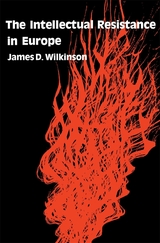 The Intellectual Resistance in Europe
James D. Wilkinson
Harvard University Press, 1981 Camus, Sartre, and Beauvoir in France. Eich, Richter, and Böll in Germany. Pavese, Levi, and Silone in Italy. These are among the defenders of human dignity whose lives and work are explored in this widely encompassing work. James D. Wilkinson examines for the first time the cultural impact of the anti-Fascist literary movements in Europe and the search of intellectuals for renewal—for social change through moral endeavor—during World War II and its immediate aftermath.
It was a period of hope, Wilkinson asserts, and not of despair as is so frequently assumed. Out of the shattering experience of war evolved the bracing experience of resistance and a reaffirmation of faith in reason. Wilkinson discovers a spiritual revolution taking place during these years of engagement and views the participants, the engagés, as heirs of the Enlightenment. Drawing on a wide range of published writing as well as interviews with many intellectuals who were active during the 1940s, Wilkinson explains in the fullest context ever attempted their shared opposition to tyranny during the war and their commitment to individual freedom and social justice afterward.
Wilkinson has written a cultural history for our time. His wise and subtle understanding of the long-range significance of the engages is a reminder that the reassertion of humanist values is as important as political activism by intellectuals.
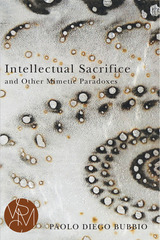 Intellectual Sacrifice and Other Mimetic Paradoxes
Paolo Diego Bubbio
Michigan State University Press, 2018 Intellectual Sacrifice and Other Mimetic Paradoxes is an account of Paolo Diego Bubbio’s twenty-year intellectual journey through the twists and turns of Girard’s mimetic theory. The author analyzes philosophy and religion as “enemy sisters” engaged in an endless competitive struggle and identifies the intellectual space where this rivalry can either be perpetuated or come to a paradoxical resolution. He goes on to explore topics ranging from arguments for the existence of God to mimetic theory’s post-Kantian legacy, political implications, and capacity for identifying epochal phenomena, such as the crisis of the self, in popular culture. Bubbio concludes by advocating for an encounter between mimetic theory and contemporary philosophical hermeneutics—an encounter in which each approach benefits and is enriched by the resources of the other. The volume features a previously unpublished letter by René Girard on the relationship between philosophy and religion.
 The Intellectual Sword: Harvard Law School, the Second Century
Bruce A. Kimball and Daniel R. Coquillette
Harvard University Press, 2020 A history of Harvard Law School in the twentieth century, focusing on the school’s precipitous decline prior to 1945 and its dramatic postwar resurgence amid national crises and internal discord.
By the late nineteenth century, Harvard Law School had transformed legal education and become the preeminent professional school in the nation. But in the early 1900s, HLS came to the brink of financial failure and lagged its peers in scholarly innovation. It also honed an aggressive intellectual culture famously described by Learned Hand: “In the universe of truth, they lived by the sword. They asked no quarter of absolutes, and they gave none.” After World War II, however, HLS roared back. In this magisterial study, Bruce Kimball and Daniel Coquillette chronicle the school’s near collapse and dramatic resurgence across the twentieth century.
The school’s struggles resulted in part from a debilitating cycle of tuition dependence, which deepened through the 1940s, as well as the suicides of two deans and the dalliance of another with the Nazi regime. HLS stubbornly resisted the admission of women, Jews, and African Americans, and fell behind the trend toward legal realism. But in the postwar years, under Dean Erwin Griswold, the school’s resurgence began, and Harvard Law would produce such major political and legal figures as Chief Justice John Roberts, Justice Elena Kagan, and President Barack Obama. Even so, the school faced severe crises arising from the civil rights movement, the Vietnam War, Critical Legal Studies, and its failure to enroll and retain people of color and women, including Justice Ruth Bader Ginsburg.
Based on hitherto unavailable sources—including oral histories, personal letters, diaries, and financial records—The Intellectual Sword paints a compelling portrait of the law school widely considered the most influential in the world.
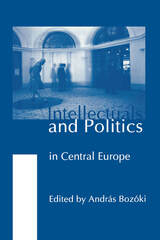 Intellectuals and Politics in Central Europe
Ivan Bernik
Central European University Press, 1999 Discussing the role of intellectuals in the political transition of the late 1980s and early 1990s and their participation in the political life of the new democracies of Central Europe, this book presents original essays from authors who discuss the eight countries in the region. In the Introduction, the editor gives a historical overview of the tradition of the political involvement of intellectuals in these countries, especially in the nineteenth century. The chapters which follow describe the typical political and social attitude of Central European intellectuals, including writers, poets, artists, and scientists. A unique feature of the book is that it deals not only with the role of intellectuals in the preparation of the peaceful revolutions in the individual countries, but also critically analyzes their role in the transition and their behavior in the emerging democracies. The most striking phenomenon, common to all the countries studied, is the disillusionment of intellectuals and their disappointment in the years following the transition, a period when the role of prophet should be replaced by that of politician for those who have chosen to stay in politics. This phenomenon has, in general, been much less subjected to systematic study than the role of intellectuals in the changes themselves.
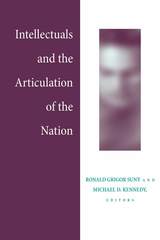 Intellectuals and the Articulation of the Nation
Ronald Grigor Suny and Michael D. Kennedy, Editors
University of Michigan Press, 2001 What kinds of intellectual practices are influential in the making and remaking of nations? How do literary texts shape nation-making? When are intellectuals most and least relevant to developing the nation? How do liberal, socialist, and nationalist intellectuals shape national ideologies?
One of the principal debates in the study of nations concerns the relative significance of elites, specifically intellectuals, in inventing the nation. Intellectuals and the Articulation of the Nation delimits the capacities of intellectuals for shaping nations, as well as the ways in which the development of nations shapes intellectual practices. The introductory chapter presents the principal debates around nation-making and the identity and practices of intellectuals. Contributors from anthropology, history, literature, political science and sociology then explore the capacities and limits of intellectuals in the formation and restructuring of national identities in general, and in Eastern Europe and the former Soviet Union in particular.
Each essay is followed by a brief intellectual autobiography in which the author's own relationship to nations is explored. The editors conclude the volume by developing a general theory of national intellectual practice.
The principal focus of this book--the mutual articulation of intellectuals and nations--is a key subject for students and scholars of history, cultural studies, political science, anthropology, and sociology.
Ronald Grigor Suny is Professor of Political Science, University of Chicago. Michael D. Kennedy is Associate Professor of Sociology, University of Michigan.
Intellectuals and the State in Twentieth-Century Mexico
By Roderic A. Camp
University of Texas Press, 1986 In developing countries, the extent to which intellectuals disengage themselves in state activities has widespread consequences for the social, political, and economic development of those societies. Roderic Camps’ examination of intellectuals in Mexico is the first study of a Latin American country to detail the structure of intellectual life, rather than merely considering intellectual ideas. Camp has used original sources, including extensive interviews, to provide new data about the evolution of leading Mexican intellectuals and their relationship to politics and politicians since 1920.
 Intellectuals, Socialism, and Dissent: The East German Opposition and Its Legacy
John C. Torpey
University of Minnesota Press, 1995 Intellectuals, Socialism, and Dissent was first published in 1995. Minnesota Archive Editions uses digital technology to make long-unavailable books once again accessible, and are published unaltered from the original University of Minnesota Press editions. Once the Berlin Wall fell in 1989, the people of East Germany had little use for the dissident intellectuals who had helped bring it down. Intellectuals, Socialism, and Dissent offers a penetrating look into the circumstances of this fall from grace, unique among the former Communist states. John Torpey traces the dissident intellectuals' fate to the peculiar situation of the East German regime, which sought to build "socialism in a quarter of a country" on the anti-fascist foundations of Communist opposition to Nazism. He shows how the regime's unusual history and subnational status helped sustain the East German intelligentsia's conviction that socialism could be reformed and humane-that there was a "third way" between Soviet-style socialism and the capitalism that took root in West Germany. How the pursuit of this third way both supported and undermined the regime, and both galvanized and alienated the East German people, becomes clear in Torpey's nuanced analysis. His book makes a powerful contribution to our understanding of the politics of intellectuals during one of the most painful chapters in modern German history. John C. Torpey is currently a Jean Monnet Fellow at the European University Institute in Florence.
 Intelligence and Surprise Attack: Failure and Success from Pearl Harbor to 9/11 and Beyond
Erik J. Dahl
Georgetown University Press How can the United States avoid a future surprise attack on the scale of 9/11 or Pearl Harbor, in an era when such devastating attacks can come not only from nation states, but also from terrorist groups or cyber enemies? Intelligence and Surprise Attack examines why surprise attacks often succeed even though, in most cases, warnings had been available beforehand. Erik J. Dahl challenges the conventional wisdom about intelligence failure, which holds that attacks succeed because important warnings get lost amid noise or because intelligence officials lack the imagination and collaboration to “connect the dots” of available information. Comparing cases of intelligence failure with intelligence success, Dahl finds that the key to success is not more imagination or better analysis, but better acquisition of precise, tactical-level intelligence combined with the presence of decision makers who are willing to listen to and act on the warnings they receive from their intelligence staff. The book offers a new understanding of classic cases of conventional and terrorist attacks such as Pearl Harbor, the Battle of Midway, and the bombings of US embassies in Kenya and Tanzania. The book also presents a comprehensive analysis of the intelligence picture before the 9/11 attacks, making use of new information available since the publication of the 9/11 Commission Report and challenging some of that report’s findings.
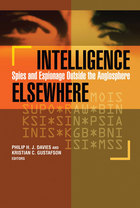 Intelligence Elsewhere: Spies and Espionage Outside the Anglosphere
Philip H. J. Davies and Kristian C. Gustafson, Editors
Georgetown University Press, 2013 Spying, the “world’s second oldest profession,” is hardly limited to the traditional great power countries. Intelligence Elsewhere, nevertheless, is the first scholarly volume to deal exclusively with the comparative study of national intelligence outside of the anglosphere and European mainstream. Past studies of intelligence and counterintelligence have tended to focus on countries such as the United States, Great Britain, and Russia, as well as, to a lesser extent, Canada, Australia, France, and Germany. This volume examines the deep historical and cultural origins of intelligence in several countries of critical importance today: India, China, the Arab world, and indeed, Russia, the latter examined from a fresh perspective. The authors then delve into modern intelligence practice in countries with organizations significantly different from the mainstream: Iran, Pakistan, Japan, Finland, Sweden, Indonesia, Argentina, and Ghana. With contributions by leading intelligence experts for each country, the chapters give the reader important insights into intelligence culture, current practice, and security sector reform. As the world morphs into an increasingly multi-polar system, it is more important than ever to understand the national intelligence systems of rising powers and regional powers that differ significantly from those of the US, its NATO allies, and its traditional opponents. This fascinating book shines new light into intelligence practices in regions that, until now, have eluded our understanding.
An Intelligence in Our Image: The Risks of Bias and Errors in Artificial Intelligence
Osonde A. Osoba
RAND Corporation, 2017 Machine learning algorithms and artificial intelligence influence many aspects of life today and have gained an aura of objectivity and infallibility. The use of these tools introduces a new level of risk and complexity in policy. This report illustrates some of the shortcomings of algorithmic decisionmaking, identifies key themes around the problem of algorithmic errors and bias, and examines some approaches for combating these problems.
Intelligence in the National Security Enterprise: An Introduction
Roger Z. George
Georgetown University Press, 2020 This textbook introduces students to the critical role of the US intelligence community within the wider national security decision-making and political process. Intelligence in the National Security Enterprise defines what intelligence is and what intelligence agencies do, but the emphasis is on showing how intelligence serves the policymaker. Roger Z. George draws on his thirty-year CIA career and more than a decade of teaching at both the undergraduate and graduate level to reveal the real world of intelligence. Intelligence support is examined from a variety of perspectives to include providing strategic intelligence, warning, daily tactical support to policy actions as well as covert action. The book includes useful features for students and instructors such as excerpts and links to primary-source documents, suggestions for further reading, and a glossary.
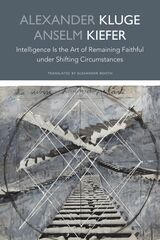 Intelligence Is the Art of Remaining Faithful under Shifting Circumstances
Alexander Kluge and Anselm Kiefer
Seagull Books, 2026 A layered and lyrical collaboration between two great artists—Anselm Kiefer and Alexander Kluge—that explores what it means to remain faithful amid the shifting forces of power, love, truth, and money.
What holds us together in times of uncertainty? For decades, artist Anselm Kiefer and filmmaker-writer Alexander Kluge have explored this question—both as friends and collaborators. This latest volume is a bold and poetic exchange of images and texts in which they delve into the idea of reliability and its relationship to the four great forces that shape our lives: power, love, truth, and money.
Moving across history, myth, and the present day, Kiefer and Kluge ask: What is time? In a world of endless change, how do we hold on to what endures? Inspired by Hölderlin’s call “to remain faithful under shifting circumstances,” they use art to keep memory alive, invite the past into the present, and welcome the future before it arrives. Layered, provocative, and profoundly human, this new collaboration is a powerful meditation on what connects us—and what makes us endure.
The Intelligence of a Machine
Jean Epstein
University of Minnesota Press, 2014
The advent of the cinema radically altered our comprehension of time, space, and reality. With his experience as a pioneering avant-garde filmmaker, Jean Epstein uses the universes created by the cinematograph to deconstruct our understanding of how time and space, reality and unreality, continuity and discontinuity, determinism and randomness function both inside and outside the cinema. Time, he says, should be regarded as the first, not the fourth, dimension—and the cinematograph allows us, for the first time, to manipulate it in directions and speeds of our choosing.
The theoretical work of Jean Epstein greatly influenced later generations of cinema philosophers, notably Gilles Deleuze and Jacques Rancière, but the bulk of his work remains unpublished. The Intelligence of a Machine, his first major title published in English, is one of the earliest philosophies of cinema.
The Intelligence of Continuation-School Children in Massachusetts
Levi Thomas Hopkins
Harvard University Press The establishment of continuation-schools and the development of group intelligence-tests to the point where they can be given to relatively large numbers at one time with the assurance of reasonably accurate results, have recently provided new data for a scientific investigation of school-mortality. Dr. Hopkins, using these two newer methods of approach, questions the validity of the old explanation of economic necessity as the main cause for children's leaving school as soon as they are able to do so. His study will attract marked attention not merely because it explores a neglected field but because his method of using intelligence-tests is full of suggestion for investigators in other educational subjects.
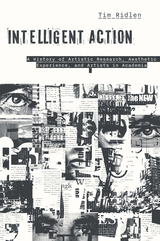 Intelligent Action: A History of Artistic Research, Aesthetic Experience, and Artists in Academia
Timothy Ridlen
Rutgers University Press, 2024 Through archival research and analysis of artworks by Gyorgy Kepes, Allan Kaprow, Mel Bochner, and Suzanne Lacy, among others, Intelligent Action examines how these artists brought alternatives to dominant conceptions of research and knowledge production. The book is organized around specific institutional formations—artistic research centers, proposals, exhibitions on college campuses, and the establishment of new schools or pedagogic programs. Formal and social analysis demonstrate how artists responded to ideas of research, knowledge production, information, and pedagogy. Works discussed were produced between 1958 and 1975, a moment when boundaries between media were breaking down in response to technological, cultural, and generational change. In the context of academia, these artistic practices have taken up the look, feel, or language of various research and teaching practices. In some cases, artists bent to the demands of the cold war research university, while in others, artists developed new modes of practice and pedagogy. Reading these works through their institutional histories, author Tim Ridlen shows how artistic research practices and artistic subjectivity developed in the long 1960s within and alongside academia, transforming the role of artists in the process.
Intelligent Control of Medium and High Power Converters
Mohamed Bendaoud
The Institution of Engineering and Technology, 2023 The growing share of renewable energies, as well as the rising demand for electricity for transport and heating, are increasing the importance of power converters and the requirements for reliability and control. Intelligent control can increase converter efficiency, reducing size and weight. The application of intelligent control techniques to power converters has therefore recently become a focus of research.
Intelligent Control Systems using Computational Intelligence Techniques
A.E. Ruano
The Institution of Engineering and Technology, 2005 Intelligent Control techniques are becoming important tools in both academia and industry. Methodologies developed in the field of soft-computing, such as neural networks, fuzzy systems and evolutionary computation, can lead to accommodation of more complex processes, improved performance and considerable time savings and cost reductions. Intelligent Control Systems using Computational Intellingence Techniques details the application of these tools to the field of control systems. Each chapter gives and overview of current approaches in the topic covered, with a set of the most important references in the field, and then details the author's approach, examining both the theory and practical applications.
Intelligent Distributed Video Surveillance Systems
Sergio A. Velastin
The Institution of Engineering and Technology, 2006 There is a growing interest in the development and deployment of surveillance systems in public and private locations. Conventional approaches rely on the installation of wide area CCTV (Closed Circuit Television), but the explosion in the numbers of cameras that have to be monitored, the increasing costs of providing monitoring personnel and the limitations that humans have to maintain sustained levels of concentration severely limit the effectiveness of these systems. Advances in information and communication technologies, such as computer vision for face recognition and human behaviour analysis, digital annotation and storage of video, transmission of video/audio streams over wired and wireless networks, can potentially provide significant improvements in this field.
Intelligent Linguistic Architectures: Variations on Themes by Ronald M. Kaplan
Edited by Miriam Butt, Mary Dalrymple, and Tracy Holloway King
CSLI, 2006 Ronald M. Kaplan has made foundational contributions to the development of computational linguistic research and linguistic theory, particularly within Lexical-Functional Grammar. Intelligent Linguistic Architectures, a tribute to Kaplan’s cutting-edge work, collects computational and theoretical linguistics papers in his research areas. From machine translation to grammar engineering, from formal issues to semantic theory, this ambitious volume represents the newest developments in linguistic scholarship.
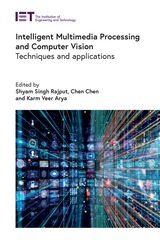 Intelligent Multimedia Processing and Computer Vision: Techniques and applications
Shyam Singh Rajput
The Institution of Engineering and Technology, 2023 Intelligent multimedia involves the computer processing and understanding of perceptual input from speech, text, videos and images. Reacting to these inputs is complex and involves research from engineering, computer science and cognitive science. Intelligent multimedia processing deals with the analysis of images and videos to extract useful information for numerous applications including medical imaging, robotics, remote sensing, autonomous driving, AR/VR, law enforcement, biometrics, multimedia enhancement and reconstruction, agriculture, and security. Intelligent multimedia processing and computer vision have seen an upsurge over the last few years. With the increasing use of intelligent multimedia processing techniques in various sectors, the requirement for fast and reliable techniques to analyse and process multimedia content is increasing day by day.
Intelligent Multimedia Technologies for Financial Risk Management: Trends, tools and applications
Simon Grima
The Institution of Engineering and Technology, 2023 Multimedia technologies have opened up a wide range of applications by combining a variety of information sources such as voice, graphics, animation, images, audio, and full-motion video which can be successfully implemented in banking, financial services and insurance (BFSI) industries to support their activities and strategic goals.
|
|

